April 14 - 27, 2019: Issue 401
Richard (Dick) Harwin Nossiter DSM OAM
Richard Harwin Nossiter, born June 22nd, 1910, grew up on the Lane Cove River, with his three brothers, Harold Charles (born 1908), John Harwin (born 1916) and Bennet Thomas (born 1919).
His father, Harold Snr., was head of the wine and spirits department for Dalgety and Co., Ltd., and Vice President of the Wine and Spirits Association of N.S.W.. From an early age Harold Nossiter senior had had a passion for the water and owned a succession of yachts as well as being a member of four yacht clubs – the Royal Sydney Yacht Squadron, Sydney Amateur Sailing Club, Royal Prince Alfred Yacht Club and the Prince Edward Yacht Club. His father, Thomas Simester Nossiter (1840-1923) had also been involved with boating on the harbour from soon after landing in Sydney, being on the committee for early Hunters Hill regattas.
On March 10th 1906 he married Winifred Shirley Piesley (born at Darlinghurst June 15th). Harold and Winifred lived at Tennyson Point, 79 Champion Road, in a house they named Harwin from their first names. It is now of historical significance as it’s one of the earliest houses constructed at Tennyson. During their time at Tennyson he didn’t have a boat.
With their now young family of four boys they bought a waterfront block of land on the shores of Woodford Bay in Northwood at 99 Northwood Road. They had a two-storey house built on the block and a stone boatshed built down on the waterfront and moved into the house in approximately 1920. Harold Snr now recommenced sailing with his young family of four boys.
From Dick’s memoirs; “Every year my father would take us to The Basin for a holiday. We would go there in a coastal steamer from Sydney to Barrenjoey where we set down all our stuff. Then there was a launch that would take us from Palm Beach to the Basin”.
Harold Nossiter and two of his sons Camping at The Basin, circa 1918
Dick’s first letter he ever wrote which was to his mother from The Basin below:
The boys also had access to ‘mucking about in boats’ on the harbour and when their father bought the famous Victorian yacht Utiekah II they were also aboard her on cruising and racing adventures on Sydney Harbour, up and down the New South Wales coast and in Pittwater for the Pittwater Regattas as much as itinerant cruises for Easter, for Christmas holidays and any other extended break of a day or two.
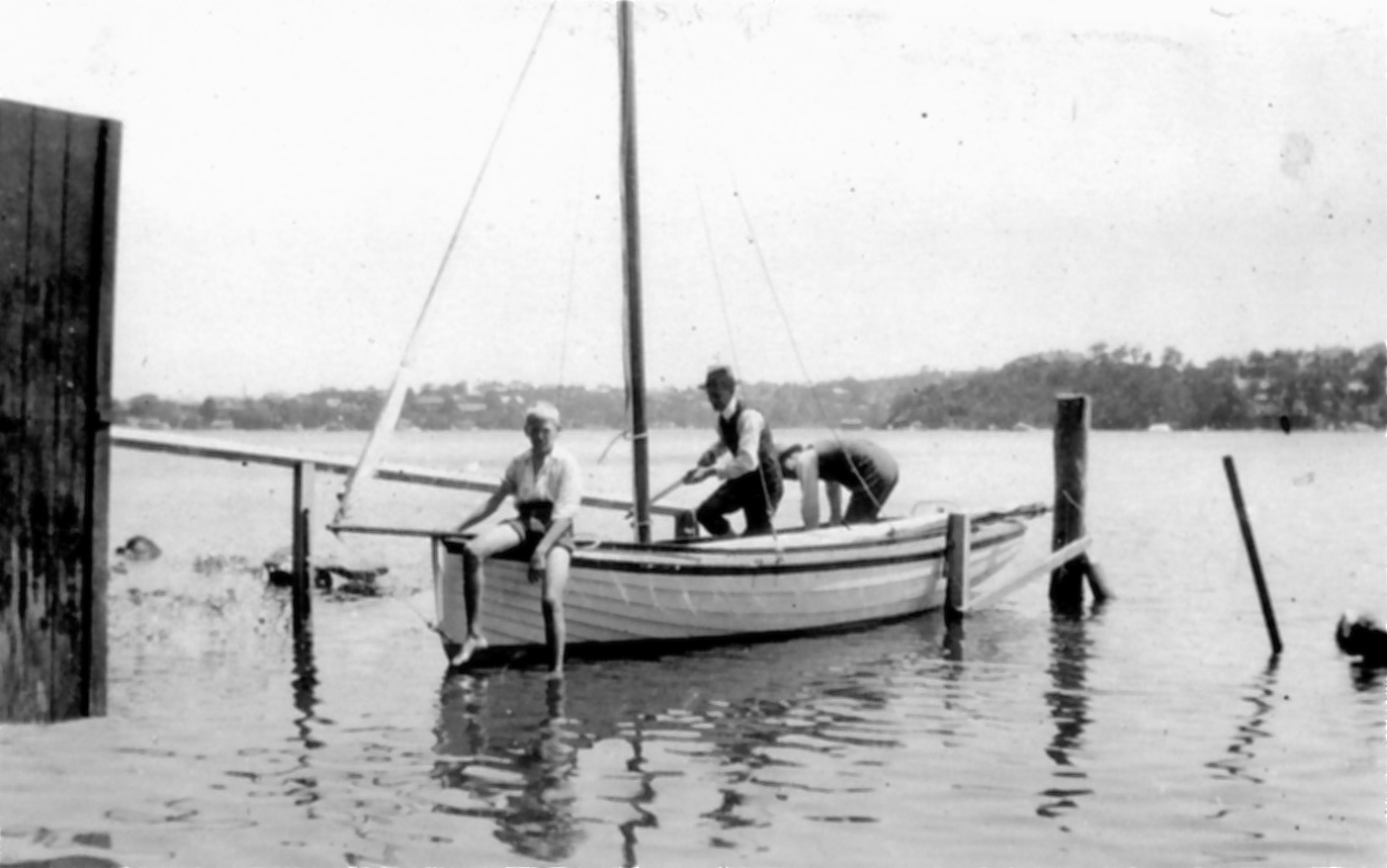
Harold's 16 footer Rocco at the Woodford Bay boatshed - 1924
As the boys grew, Harold ventured further afield with an annual two-week summer cruise up or down the NSW coast. He also became very serious about racing Utiekah II and had her rig changed from gaff to Bermuda, one of the first yachts on the harbour with this new, modern rig. He was so competitive that during the racing season he removed anything of weight he felt unnecessary: bunks, toilet etc, and even the engine. There were the odd occasions after a race that, due to lack of wind, the crew (that is, mainly sons Harold jnr and Dick) had to row the yacht home.
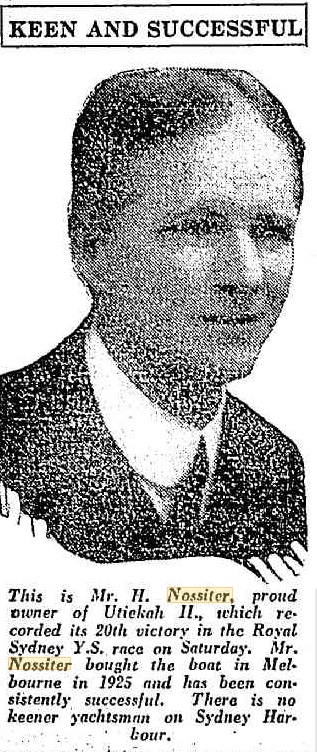
AUSTRALIANS AT THE WATER SPORTS (1931, November 25). Referee (Sydney, NSW : 1886 - 1939), p. 22. Retrieved from http://nla.gov.au/nla.news-article136745802
At the age of 25 Richard played a crucial part as the navigator in an historic voyage undertaken by his father, Harold Nossiter snr, and elder brother, Harold Nossiter jnr.
Harold snr had long talked about a world circumnavigation and with the approach of his retirement put his plan into action. He took his ideas to J.D. Thistlethwaite, a naval architect, to design his ship. The ideas turned into a canoe-stern staysail schooner of some 35 tonnes displacement, 16 metres on deck and 18.9 metres overall. This magnificent all-timber vessel, built in Careening Cove by James Hayes and Sons, was a masterful piece of Australian design and workmanship to be showcased to the world. She took a little over a year to build and was launched in the presence of 300 guests on February 6, 1935, christened by Winifred as Sirius, after the brightest of all stars.
For the voyage, Dick learned navigation, both terrestrial and celestial, and meteorology. He also taught himself semaphore and Morse Code, and in 1933 took the Yacht Masters exams and was duly given his credentials - this was the second Yacht Master Certificate issued in Australia.
Richard Nossiter's Yachtmaster Certificate front
Richard Nossiter's Yachtmaster Certificate back
PLANS WORLD CRUISE
NEW YACHT, MERMAID
HAROLD NOSSITER IS BUILDING FINE VESSEL
By "BERMUDA"
PLANNING a world's cruise to last two years, Mr. Harold Nossiter, has a new yacht, the Mermaid, under construction at Messrs. J. Hayes and Son's yards at Neutral Bay. The course or cruise will be from Sydney northward through Torres Strait to Java, Singapore, and Ceylon, then through the Red and Mediterranean Seas, to England. The return voyage will be made via the Panama Canal.
The Mermaid is to be an exceptionally fine type of auxiliary cruising yacht of 34 tons. Designed with a spoon bow and cruiser stern, her principal dimensions will be length 54ft., beam 13ft. 6in„ draught 7ft. 6in. An 18 h.p. Jersey City Standrad engine will provide auxiliary power.
Mr. Nossiter will be accompanied by two of his sons, R. H. Nossiter, who will this week sit for an examination for a foreign-going yacht master's certificate, and J. Nossiter. PLANS WORLD CRUISE (1933, October 19). The Daily Telegraph (Sydney, NSW : 1931 - 1954), p. 4. Retrieved from http://nla.gov.au/nla.news-article247162044
The yacht was named 'Sirius' and she was launched February 2nd, 1935. Harold Snr. aimed to not only be the first Australian skipper to circumnavigate the globe but to also do it on an Australian built and Australian comprised yacht to showcase this craftmanship to the world. He also hoped to introduce the idea of sailing in Australian waters to overseas yachtsmen and women - now something quite commonplace in events such as the Sydney to Hobart or the attractions Queensland events such as Hamilton Island Race Week hold for those who fly south to be among the sunny and warm Winter Sailing regattas.
This spirit of sharing the Australian passion for sailing, not to be underestimated in a nation that is an island and during an era when there were no international flights or airports, remained a lifelong pursuit for Harold Nossiter's sons too - they were loyal to and proud of Australia and Australian ingenuity and expertise as well as being 'of service' to others and doing their bit.
Around World In 30-Ton Yacht
FAMILY'S 2-YEAR CRUISE
SYDNEY, Wednesday. — Four Australians will set out on Sunday to circumnavigate the world in the 30-ton yacht, Sirius, marking an epoch in such ventures in an Australian-built craft of this size. The party will comprise Mr Harold Nossiter, of Northwood Road, North-wood, the owner; his sons. Harold, 27, and Dick. 25, expert yachtsmen, the latter holding a yacht-master's certificate; and Mr Clive Russel, 28, of Melbourne. Farewells have been tendered Mr Nossiter by the Royal Yacht Squadron, to which he belongs, and the Prince Edward Yacht Club.
The yacht will carry a wireless set, enabling world-wide reception, but no transmission. The Sirius is 53ft. 6in. long, with a 13ft. 7in. beam, and draws 7ft. 6in. The auxiliary 18 horse-power petrol engine in the staysail schooner rigged yacht will j not be used except in ports or in case of emergency.
All-Australian Venture
At 11 a.m. next Sunday, escorted by other private craft, the four adventurers ;will sail from Woodford Bay. Lane Cove River, carrying from 15cwt. to 1 ton of stores— all Australian, and expected to: last for the two years allotted for the! voyage. Mr Nossiters patriotic zeal permeates every aspect of the projected adventure. All Australian material was used in the yacht by the builders, F. Hayes and Sons.
In the choice of the name Sirius, Mr Nossiter explained today, he was guided by several influences. Sirius was the flagship on which Governor Phillip entered Port Jackson at the head of the first fleet. "It is the brightest star in the heavens, and a southern star, and therefore Australian." added Mr Nossiter.
Sirius Cove has pleasant associations for him and it was in Sirius House, Macquarie Place, not far distant from the first Government House where lived Governor Phillip, that were held meetings of the Wine and Spirit Merchants' Association, of which Mr Nossiter was a vice-president until his retirement for this venture. Around World In 30-Ton Yacht (1935, July 10). The Herald (Melbourne, Vic. : 1861 - 1954), p. 10. Retrieved from http://nla.gov.au/nla.news-article244935985
YACHT SIRIUS RETURNS.
Romantic Voyage Ends.
GALE IN SIGHT OF HOME.
The yacht Sirius, which left Sydney on July 14, 1935, returned early last night, having completed a voyage of 30,000 miles round the world. The crew, comprising the owner, Mr. Harold Nossiter, and his sons, Messrs. R. W. and H. C. Nossiter, were unable to leave the yacht because of quarantine and Customs regulations. Quarantine regulations also prevented anyone from boarding the Sirius, but Mr. Nossiter was interviewed across several feet of water from a launch soon after he dropped anchor in Watson's Bay.
THE LAST STAGE.
The last stage of the world voyage was from Tonga to Sydney, a distance of 2200 miles, which took 25 days. The New South Wales coastline was sighted near Grafton 20 days out, but a south-west gale sprang up suddenly. It lasted for three days, during which the Sirius was hove-to.
Mr. Nossiter said that it was undoubtedly the worst blow encountered on the whole voyage, and it was annoying to meet it within sight of home. The yacht's sails were torn to ribbons, and the crew had to ride the gale out under bare poles. He estimated that they were blown 70 miles out to sea. Before they could resume, the sails had to be repaired or replaced by spares.
Between Panama and Sydney, the Sirius did not sight a single vessel, and at times, Mr. Nossiter said, the feeling of loneliness was Indescribable.
SUMMARY OF THE VOYAGE.
The Sirius made the first stage of the voyage to England via the Suez Canal. It encountered a severe gale In the Gulf of Lyons. The Atlantic crossing was achieved by way of Madeira and Trinidad to Panama, On the voyage from Panama to Sydney, the yacht called at Cocos Island, Galapagos Island, the Marquesas, Papeete, Tahiti, the Tumutu Archipelago, Bora Bora, Rarotonga, and Tonga.
Mr. Nossiter said that wherever the Sirius went it was admired by yachtsmen, especially in England. Its design, rig, and construction, they said, did great credit to Australia. Others were amazed at the amount of sail carried on a craft managed by only three hands. The beauty of the Australian timbers used in the Interior was also praised. YACHT SIRIUS RETURNS. (1937, May 21). The Sydney Morning Herald (NSW : 1842 - 1954), p. 11. Retrieved from http://nla.gov.au/nla.news-article17369977
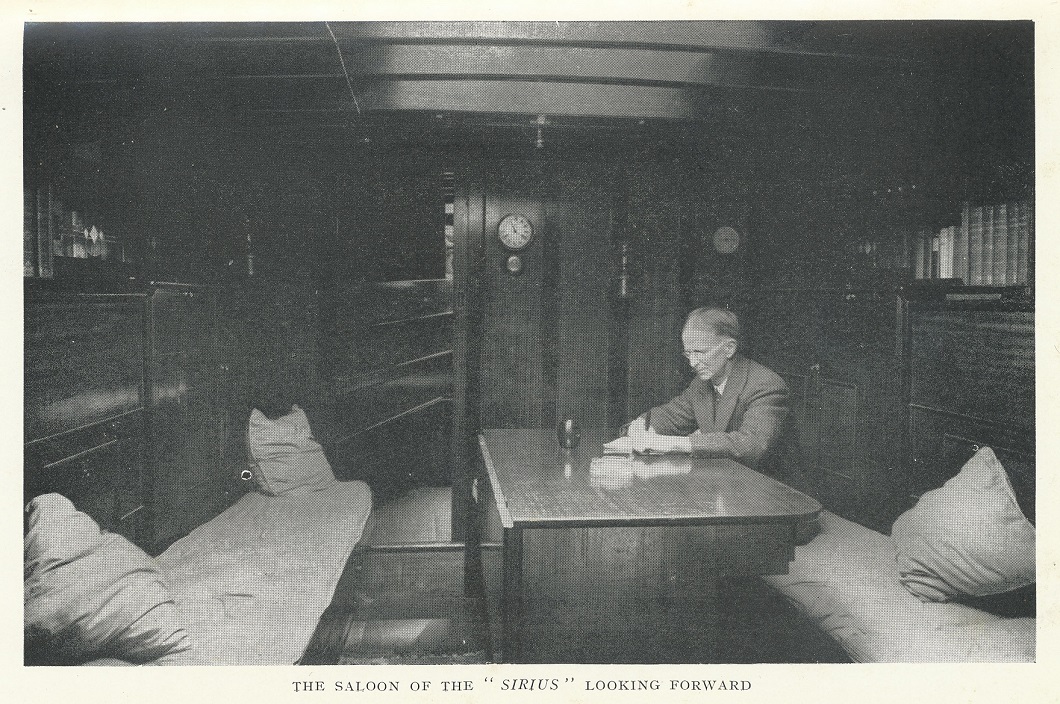
Harold Nossiter, owner and Skipper in the Main Saloon
The launching of Harold Nossiter's the Sirius on February 6th, 1935
After the launch of the Sirius, he chose to live aboard. Among the many things he did to prepare for a long voyage was hand-make about 50 wooden blocks for the running rigging, as the only winch they had aboard was a hand-operated anchor one.
On July 14th, 1935, two days after Harold snr. retired, Sirius set off with Harolds snr. and jnr. and Dick on board. The two younger boys, John and Ben, stayed at home with Winifred, who was not a keen sailor.
OFF ON WORLD'S CRUISE
Mr. Nossiter's Aim
(By 'FOR'ARD HAND')
MR. HAROLD NOSSITER, for many years a prominent yachtsman in New South Wales waters, and who for several seasons won many valuable prizes with the Victorian built Utiekah II, which he sold some months ago, left Sydney in his new auxiliary-engined staysail schooner 'Sirius' on Sunday on a two years' cruise of the world, accompanied by his two sons Richard and Harold, and Mr. Clive Russell.
THE 'Sirius' is an expensively fitted craft, 53ft 61n over all, with a beam of 13ft 7in, and rigged to carry a large spread of canvas. The voyage will be made in a leisurely fashion, the projected route being through the East Indies, thence via Suez to England. Afterwards the 'Sirius' will cross the Atlantic to New York and will return via the Panama Canal. The navigator is Mr. Richard Nossiter, who has a master's certificate, having passed all examinations with first-class honors.
Mr. Nossiter was tendered a farewell dinner by the Royal Sydney Yacht Squadron on July 17. The Commodore, Mr. Paul Ross, presided, and was supported by Vice-Commodore J. L. Milson, and Rear-Commodore, Dr. R. I. Furber. They wished Mr. Nossiter a successful voyage, and Mr. Ross said that he hoped Mr. Nossiter will call on the leading yachting organisations of the world and will return with nautical information that should be of immense value to the boating men of Australia. He was presented with suitable gifts: letters of introduction and a burgee of the Royal Sydney Yacht Squadron.
The craft left Sydney in glorious sunshine, and was accompanied down the harbor from his home on the Lane Cove River by the fleet of the Royal Sydney Yacht Squadron and Royal Motor Yacht Club of N.S.W. It was a fitting farewell, and even the ferries on the harbor added their best wishes with sirens blasting a cock-a-doodle-doo.
OWNER'S FAREWELL MESSAGE
In a farewell message to 'The Referee,' Mr. Nossiter said that it had always been his ambition to circle the seven seas, and while abroad he would gather all the' information possible regarding yacht racing. 'Tell yachtsmen,' he said, 'that the 'Sirius' is fitted out to meet all kinds of weather, and when away I will endeavor to induce overseas enthusiasts to travel to this part of the world and take part in the big events in Australian waters.'
WIRELESS EQUIPMENT
The 'Sirius' has an Interesting wireless receiver. It will tune to entertainment, stages, and also to shortwave stations, which transmit international time signals. The Installation was designed by Amalgamated Wireless, Ltd. During the tests, signals of Paris on 25 metres came in as clearly as the local stations. Shell have laid down petrol supplies for the trip. OFF ON WORLD'S CRUISE (1935, July 18). Referee (Sydney, NSW : 1886 - 1939), p. 15. Retrieved from http://nla.gov.au/nla.news-article135514130
The first landfall was to be Rabaul, New Guinea and the town duly appeared on the horizon dead ahead, which was very encouraging for Dick as the navigator.
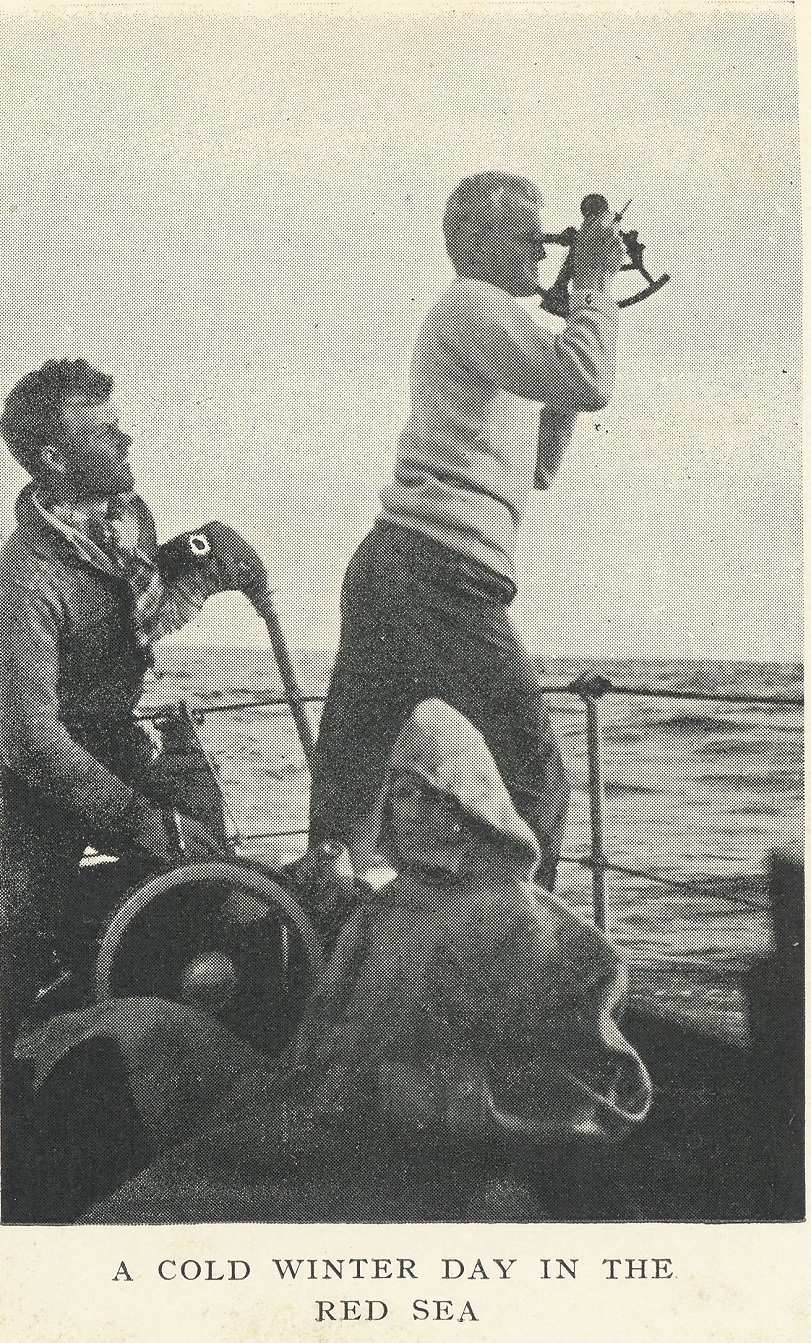
Richard at sea with sextant
Sailors' Superstition
A SUPERSTITION among sailors is that the tail of a game fish nailed to the end of the bowsprit ensures fair winds and safe guidance. Mr. E. P. Andreas, noted game fisherman and yachtsman, bethought himself of this as his friend, Mr. Harold Nossiter, was about to set out on a world cruise in his yacht, Sirius, and presented the owner-skipper with the tail of a tunney. This was stowed away, but heavy head winds, encountered between Sydney and the Clarence River entrance, impelled Mr. Nossiter to respect the superstition. Thereafter he had fair winds to Rabaul, from where he wrote to express his faith in the tunney tail. A Stroller in the TOWN (1935, August 21). The Daily Telegraph (Sydney, NSW : 1931 - 1954), p. 6. Retrieved from http://nla.gov.au/nla.news-article246598210
Natives Knew Of The News
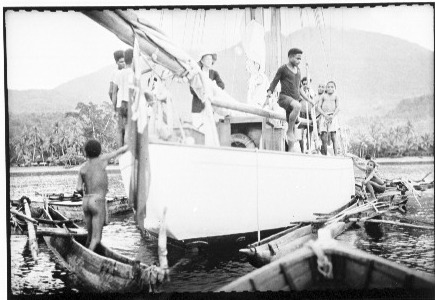 THROUGH a native servant, "bush telegraphy" apprised a New Guinea settler of the approach of Mr Harold Nossiter's yacht, Sirius, two days before Its arrival. This Incident, which he described as "most extraordinary." was related by Mr. Nossiter In a broadcast last night dealing with his voyage round the world in the Sirius, which ended when he returned to Sydney last Thursday.
THROUGH a native servant, "bush telegraphy" apprised a New Guinea settler of the approach of Mr Harold Nossiter's yacht, Sirius, two days before Its arrival. This Incident, which he described as "most extraordinary." was related by Mr. Nossiter In a broadcast last night dealing with his voyage round the world in the Sirius, which ended when he returned to Sydney last Thursday.
This incident, which he described as “most extraordinary” was related by Mr. Nossiter in broadcast last night dealing with his voyage around the world in the yacht Sirius which came to an end when he returned to Sydney last Thursday.
On another occasion the radio came to his rescue in on encounter with friendly natives who became too friendly. "They came aboard uninvited, and before I knew where I was they were swarming all over the deck. Then I switched the radio on, and it was not long before I had a' clear deck," he added. Mr. Nossiter's chief impression of Colombo was that "begging was rife and robbery a common-place."
On the return voyage through the Pacific Islands, the Sirius narrowly escaped destruction by an enormous waterspout, and near the Australian coast the yacht encountered one of the roughest gales of the trip. "We hove to for three days practically within a stone's throw of Sydney," said Mr. Nossiter. Natives Knew Of The News (1937, May 26). The Labor Daily (Sydney, NSW : 1924 - 1938), p. 4. Retrieved from http://nla.gov.au/nla.news-article236459981
"This photo is a girl, Dee, that Dad obviously became very attached to while in Batavia/Jakarta and I happened to find the photo his brother took of them at the time." - Tim Nossiter
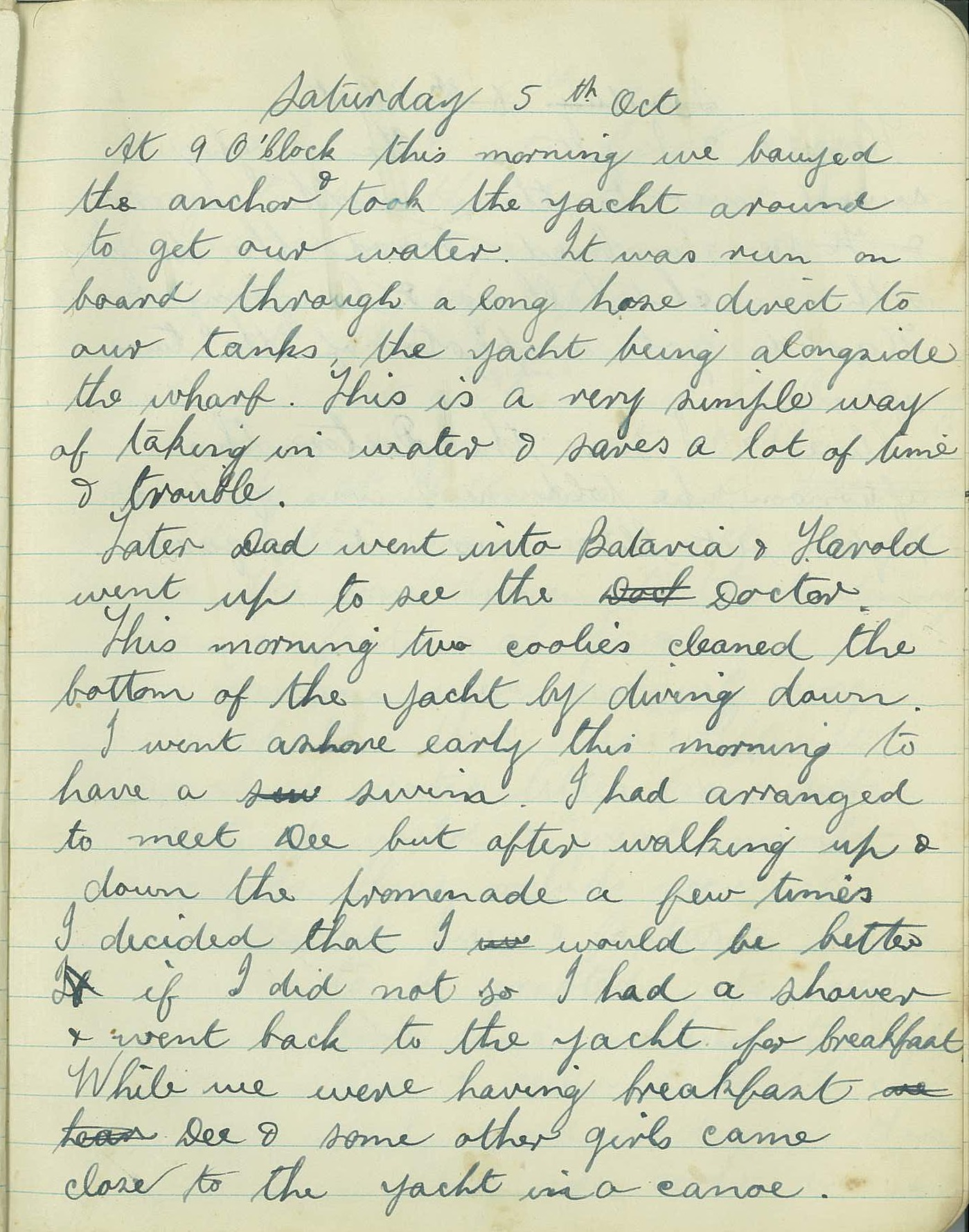
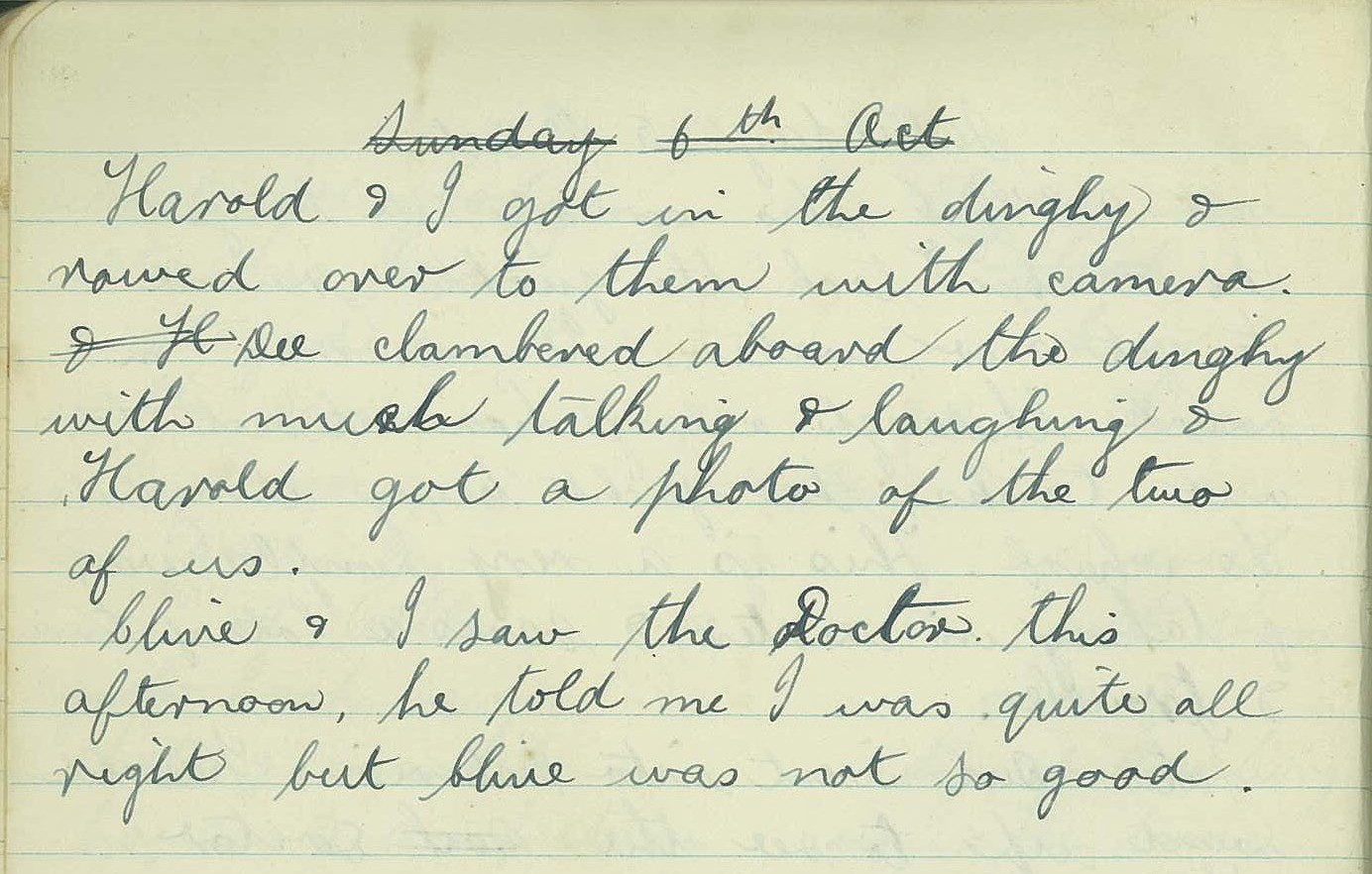
"Dad had an accident while sitting on his bunk cleaning his Winchester rifle. He accidentally discharged it shooting a hole right through the hull, luckily above the waterline. His father was not impressed and it's a story we heard a lot about." - Tim Nossiter
Galapagos (by Tim Nossiter)
Galapagos was dad's favourite and most interesting port of call during the circumnavigation, in fact it was for all the crew. They spent ten days anchored in Academy Bay on the main Island of Santa Cruz. The Galapagos Archipelago was barely settled when they sailed in, the total population on Santa Cruz Island was then about 24 whereas today it has an estimated population of about 12,000. All their time on Santa Cruz was spent with the Kubler family who had settled there from Germany about eighteen months beforehand.
During the day they went exploring, hunting and fishing, and in the evenings dining together, playing music and dancing. At the time the Kubler’s had a nine year old daughter Carmen and a photo of her standing in the water holding onto the tail of an iguana is featured on page 65 in Harold Nossiter's book Southward Ho.
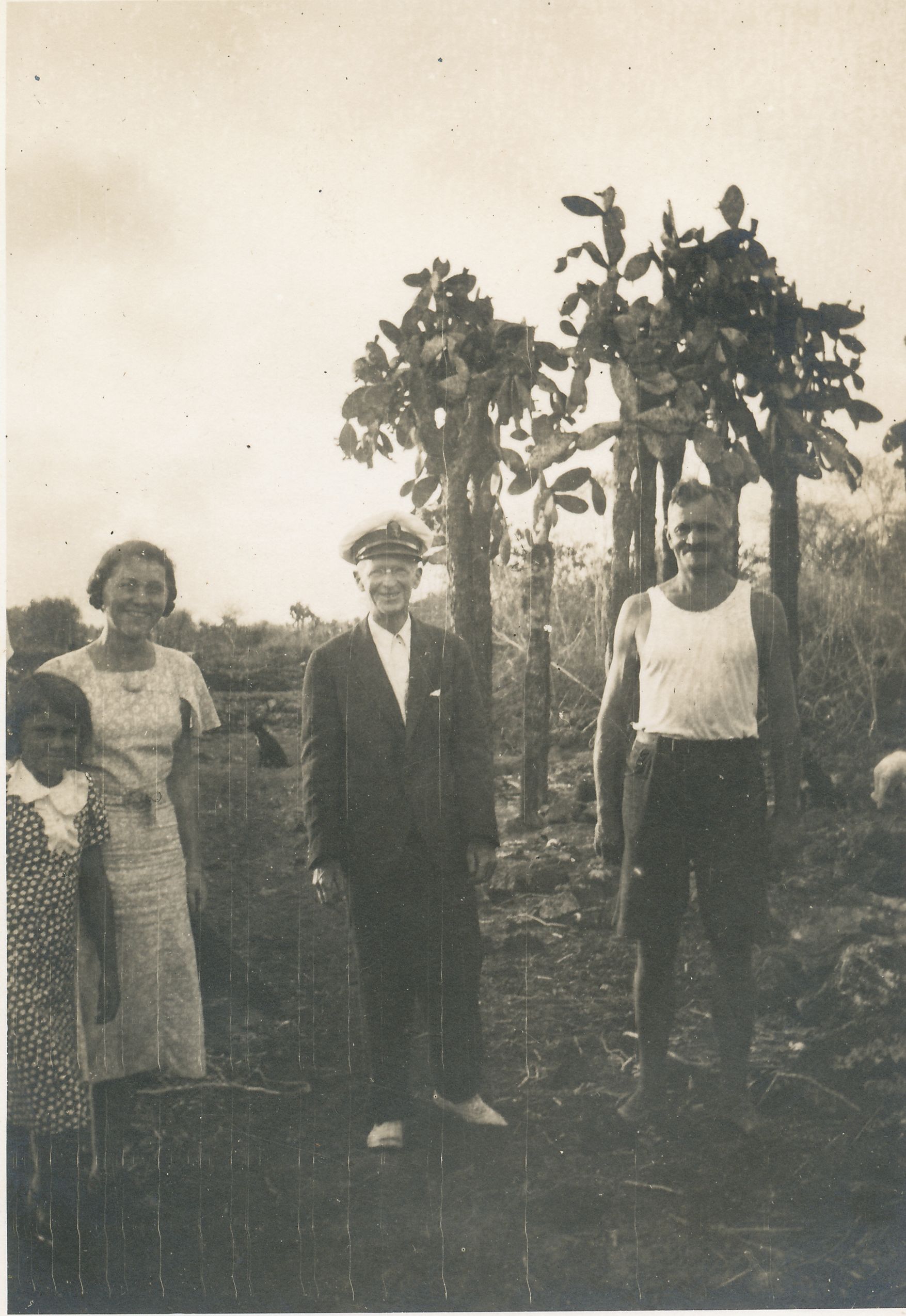
The Kubler family
In 2011 Pam and I were planning a trip to South America including a trip to Galapagos where we wanted to do a cruise around the islands. It suddenly dawned on me that Carmen may still be in Galapagos and thanks to Google I soon found out she certainly was. Not only was Carmen Angermeyer (her married name) still living on Santa Cruz but was now the longest living resident of Galapagos and also her son Fiddi owned a cruise business. There was no other cruise we could then go with but his. It even gets better, one of the three vessels he operates in Galapagos is a beautiful three masted barquentine Mary Anne, so we immediately booked a cruise for December that year. Carmen's granddaughter was our guide for the cruise and after the cruise we spent another four days in Santa Cruz staying only a few doors from Carmen's home.
The barquentine Mary Anne
Carmen vividly remembered the Nossiter's visit every bit as much as dad remembered it and was delighted when I rang dad (then 101) at his home in Newcastle and handed her the phone. It was lovely to hear them chat and reminisce about their lives over the 75 years since Sirius visited Galapagos. I handed her a copy of the books, Northward Ho and Southward Ho, my grandfather had written with an inscription in Northward Ho to Carmen from dad. She got quite a surprise to see the photo of herself in the book after so many years had passed.
Carmen Angermeyer talking on phone to Dick Nossiter, Tim Nossiter beside her
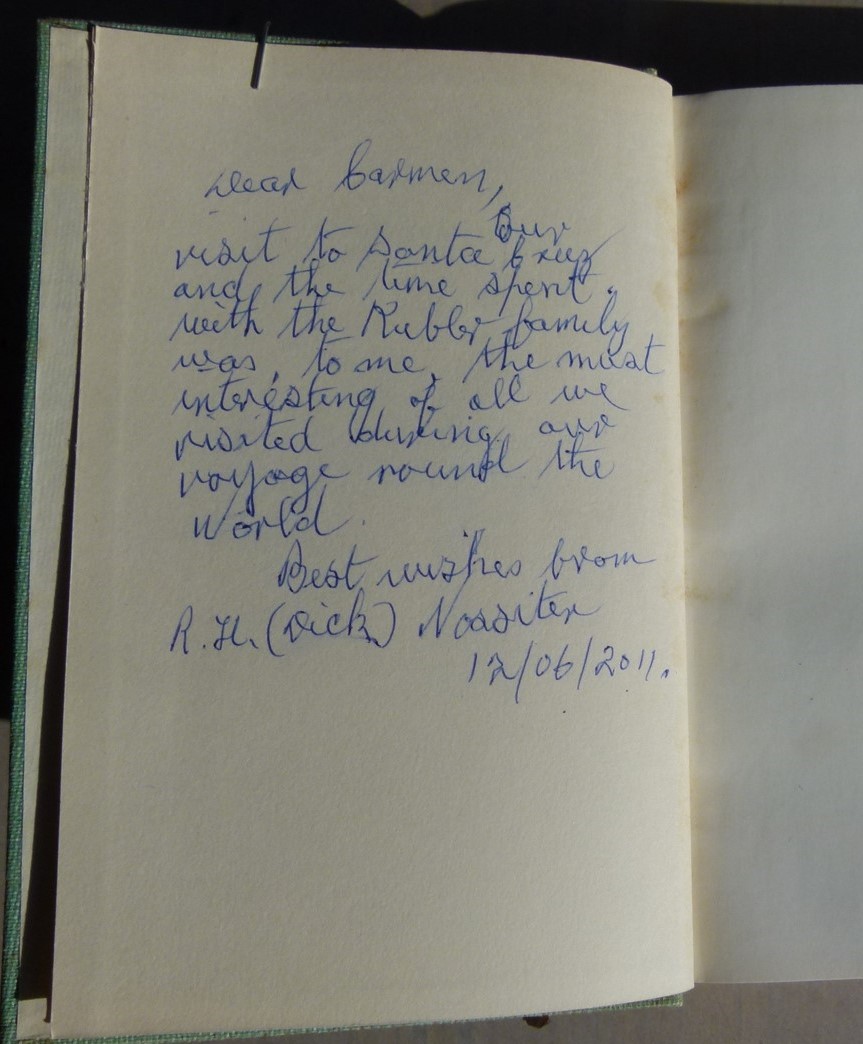
"We were honoured to be invited to Carmen’s 84th birthday the next day and meet the rest of her family. We called in to see her every day we were there, a very sprightly lady and she invited us to stay any time we returned to Santa Cruz.
Another thing quite relevant to the Sirius circumnavigation is about one of my cousins, Michael Nossiter. Michael is the son of John, Harold Snrs third eldest son. Michael and his then wife Annette followed in our grandfather's footsteps and did a six year circumnavigation in the 70's, basically retracing Sirius's track, in a small 30 foot yacht, Palermo. Mike also skippered charter yachts in the Caribbean for about five years. Mike now lives on South Steyne in Manly with his current wife Sheridan.
The men spent three months in Britain, mainly at Cowes. Dick and Harold jnr raced on a number of yachts, including one race to France, and Harold snr wrote Northward Ho, relying heavily on Dick's diary of the voyage. He later wrote Southward Ho on the journey home. Both books were published in Britain and the US.
The return voyage followed the trade winds. Sirius left Cowes on September 17, 1936, sailed to Madeira then caught the trades to Trinidad, went through the Panama Canal and headed out into the Pacific. Christmas 1936 was spent at sea, becalmed in the doldrums on their way to Cocos Island and Galapagos, but soon enough Sirius was under way again, on the longest passage of the trip, 5000 kilometres and 19 days of (fortunately gentle) wind to the Marquesas. The dangerous Tuamotu Archipelago followed, but Dick safely navigated them through. It was then on to the Society Islands of Tahiti and Bora Bora and from there to Rarotonga in the Cook Islands.
Their final port of call was Nukualofa in the Tongan Islands. They stayed for five days, visited the site of Captain Cook's landing and were told that a tortoise, given to the King of Tonga by the famous explorer, was still living in the palace grounds (the tortoise, known as Tu'i Malila, died in 1965)." - Tim Nossiter
Sailing Home In The Yacht Sirius
FROM September 17, 1936, to May 21, 1937, Mr. Harold Nossiter of Sydney, with his two sons, Harold and Dick, was occupied in sailing his yacht, Sirius back from England to Australia, via the Panama Canal and the Pacific Islands, a voyage of 14,422 miles.
In his book "Northwood Ho," Mr. Nossiter had already narrated the voyage of the Sirius from Australia to England; and the new book "Southward Ho," tells the story of the return journey.
There were no serious mishaps during the long adventure, there were many exciting days.
SUCH a voyage is by no means a long picnic, though the Nossiters enjoyed many picnic interludes in places where they landed — notably among the islands away from normal shipping routes. When Mr. Nossiter gives a day's diary you see how the yacht's crew was kept on the job pretty well all the time. The night hours, twelve hours from 7 to 7, are divided into six watches of two hours each. Each of the three has a two-hour watch at n time, so that each of them has twice within the twelve hours a four-hour spell for sleep.
IN the daytime, unless the weather is foul, there is no need for special allotment of watches, but there is enough for all those to do.
Harold is the head cook, and does very well with a variety of ingredients, filling up his larder with unusual grub obtained in out-of-the-way places. At first, you find Harold peeling spuds for a potato pie, making damper, and creating an olio which is "a cross between a hash and an ordinary soup, with meat and vegetables floating round." There is mention of plum-pudding, but, whether mixed in good housewife fashion or dumped from a tin, we are not told.
LATER on (after leaving the Galapagos Islands, for instance), Harold has menus which would not be served in Artarmon or Strathfield. Breakfast — oatmeal porridge; bananas fried in turtle oil; yacht-made bread.
THE Nossiters found the Galapagos Islands, off the coast of Ecuador, a storehouse of new provisions. Their hosts were the Kuebler family, man, wife, and daughter Carmen, aged nine. "Kuebler and my sons returned at night, having shot three swine with revolvers. The pork was excellent. "Kuebler took us lobster-fishing the next day. We went to some rocks which were along the shore, and, stooping over them, Kuebler felt underneath, and brought out lobster after lobster until we had about twenty." These were boiled and put in brine for the yacht's larder. "Truly a land of plenty," says Mr. Nossiter. "No need to work. ' Bananas, pawpaws, anything will grow that is stuck in- the soil; turtles, turtle-eggs, pigs in plenty, a climate that is quite cool for the tropics; no taxes, and, as far as I can gather, practically no duty. Residents fence in the land they want with stones and just/live a life of ease, growing enough cotton and coffee to sell."
Earlier in the voyage, and before going through the Panama Canal, the party took a pleasant spell in Trinidad, and at the neighboring Monos Island, where they chummed with Dr. Tothill, commodore of the San Fernando Yacht Club. They found something of interest to Sydney swimmers: "No one worries about sharks here. We would swim from the yacht to the doctor's home, and he and his friends would swim out to us. People in Trinidad, however, are very much afraid of the barracouta, which sometimes attack in schools."
THERE is a vicious species of barracouta in Australian waters also. The longest spell for the Sirius on the Pacific Ocean was from the Galapagos to the Marquesas Islands, a 3000-mile stretch. They set out with a fine supply of vegetable food — bananas, pumpkins and. yams. Mr. Kuebler, in the Galapagos stay, gave them a bunch of 200 bananas — a pleasant gift, but not costly, for such a bunch on the Santa Cruz plantation is worth twopence Australian.
THE long stretch of ocean was covered in less than three weeks, January 25 to February 13. The day's runs of the, Sirius show a consecutive series of good figures. Take the first week in February, with the daily mileages 173, 160, 185, 185, 180, 155, 143.
The Marquesans have a past more exciting than their present. "I was interested here," Mr. Nossiter says, "in the sacrificial stones seen in a valley where the Marquesans slew their victims of war, afterwards devouring them. There were seats around the sacrificial altar where the chiefs viewed the slaughter, and other seats of stone for those of lesser degree. The chiefs generally ate the eyes and other appetising morsels of the victims. "An old Marquesan said that the Marquesans used to be more partial to negroes than to whites as an article of diet."
THE sore spot of the Marquesas nowadays is leprosy. In these islands the two sons, Harold and Dick, showed how a yacht can be treated without docking or hauling ashore. The propeller was fouled with shell:— "Harold and Dick dived under the yacht, and with a large knife cleaned the propeller and removed with a coarse cloth the barnacles from the sides, which were covered with shell. The foul state of the propeller had greatly retarded the yacht's progress under sail and power."
MR. NOSSITER did not make constant use of his auxiliary power, but relied for the most part on sail; however, when he next brought his engines into use he found that there was two knots difference in speed between the dirty propeller and the clean one. Via the Tuamotus to Tahiti. In Tahiti Mr. Nossiter did not find ' all the glamor which is contained in seafaring tradition : — "Many white men became infatuated with Tahitian women. . . . There is a glamor about these women, for they have a reputation for beauty which seafarers have given them in the past, but any woman would have looked beautiful to the old sailor who was cooped up on a ship for months away from the fair sex."
MR. NOSSITER allows to Tahitian belles their lovely gleaming eyes, but will not admire their broad noses. The spread of Chinese traders all the way across the Pacific leads Mr. Nossiter to recount a traveller's tale: — "I have heard of the captains of ships taking Chinese as cargo to certain parts of America. When nearing the port of discharge, they place them in sacks or other containers, with stones inside, landing them safe, and sound when not challenged by revenue officers. If the vessel is chased by a revenue cutter, the sacks are dumped over the side; and when boarded, nothing is found on the ship to incriminate the captain, for the Chinks are at the bottom of the sea."
AT length, via the Cooks and Tonga, the Sirius came back to Sydney, after going through a burst of furious storm almost at the end of her journey. It is a valuable narrative for sailing men, being full of hints to real yachtsmen.
Mr. Harold Nossitor and two sons, Richard, (in white iersev) and Harold. SAILING HOME IN THE YACHT SIRIUS (1938, January 4). The Sun (Sydney, NSW : 1910 - 1954), p. 4 (LATE FINAL EXTRA). Retrieved from http://nla.gov.au/nla.news-article231110342
"The next couple of log entries are their arrival home but by this stage I think Dad was a bit tired of writing his diary so there are only log readings included. This was also the tail end of a storm they struck one day out from Sydney, the worst storm of the whole trip. They ended up under bare poles for about three days before finally reaching the harbour. It would have been extremely frustrating so close to home and family." - Tim Nossiter
The Sirius dropped anchor in Watsons Bay, Sydney on May 20th, 1937. As she did Harold Nossiter and his sons Dick and Harold became the first Australians to circumnavigate the world in a yacht. They had sailed Sirius 28,145 nautical miles, making her the first Australian-built yacht to achieve this remarkable feat.
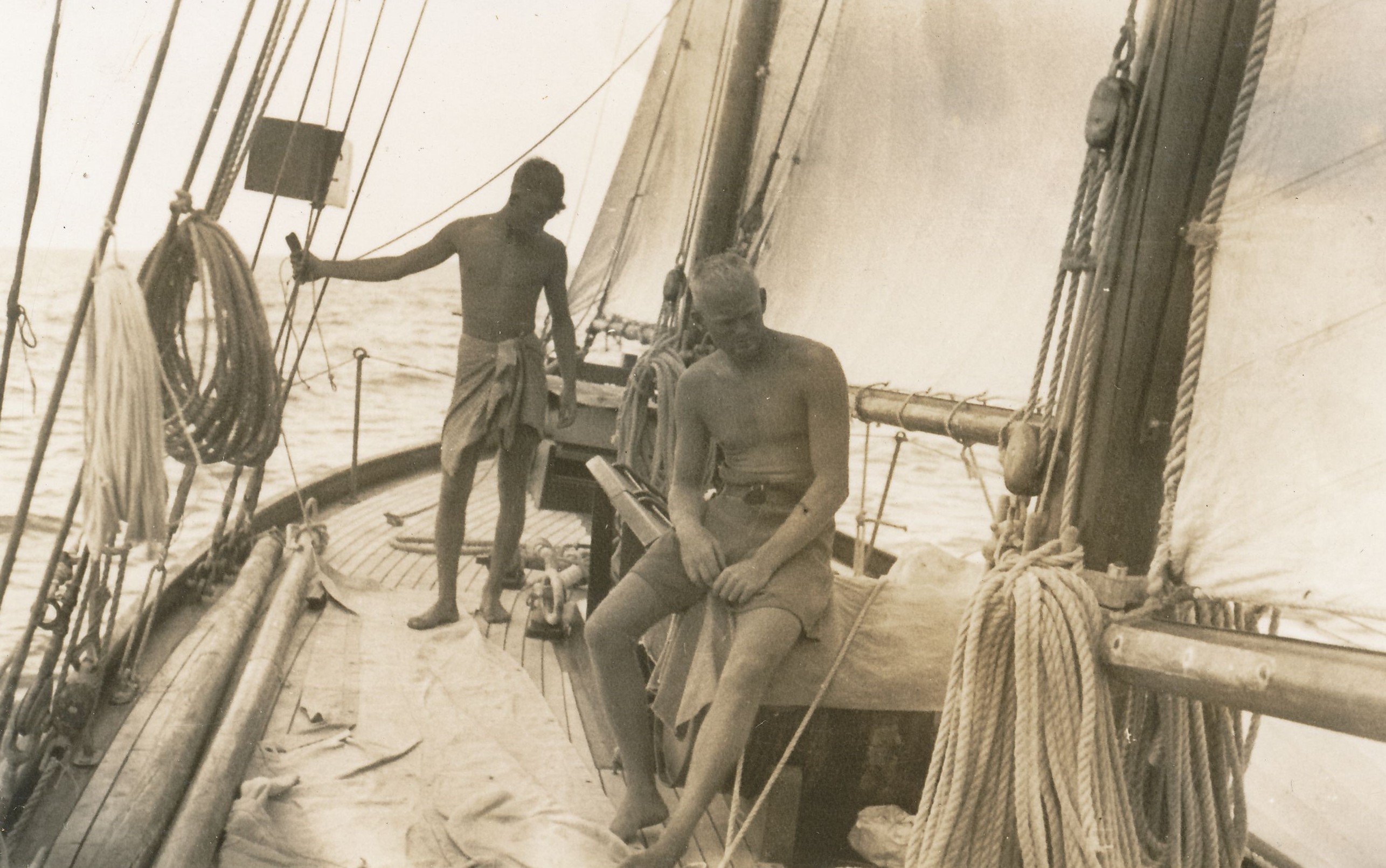
The Nossiter sons at sea aboard the Sirius
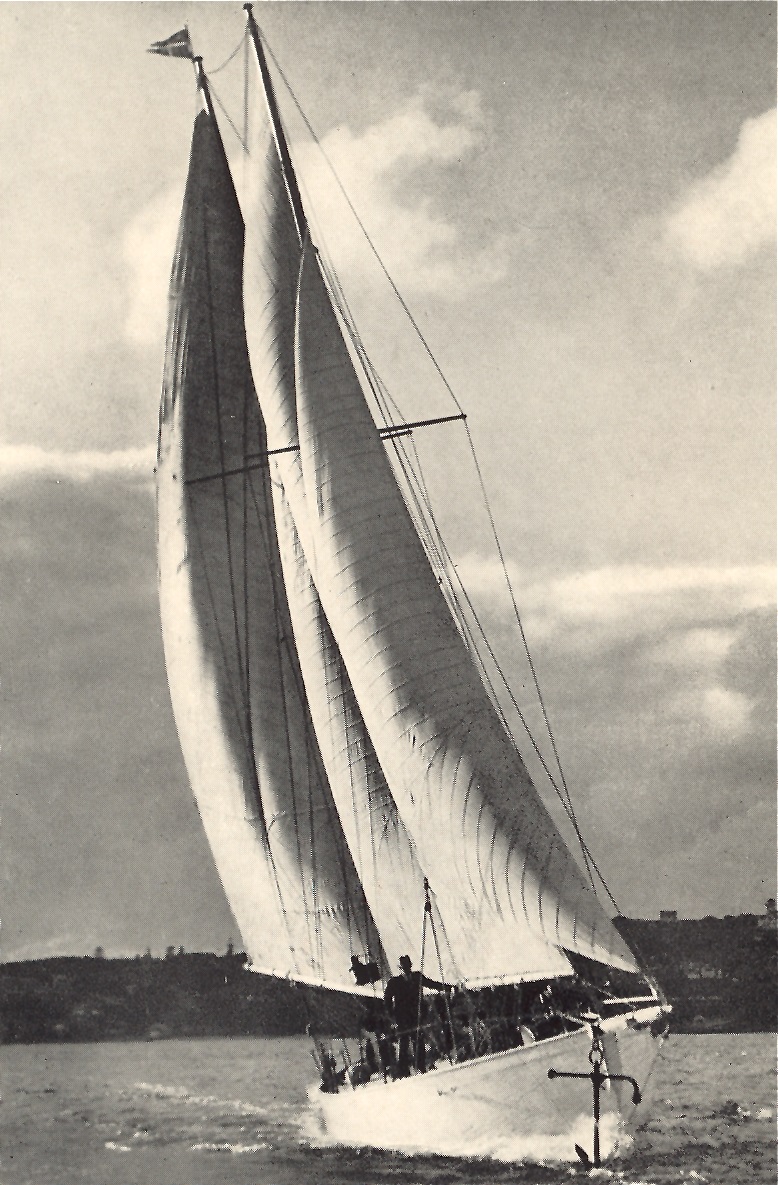
Sailing Home - 1937
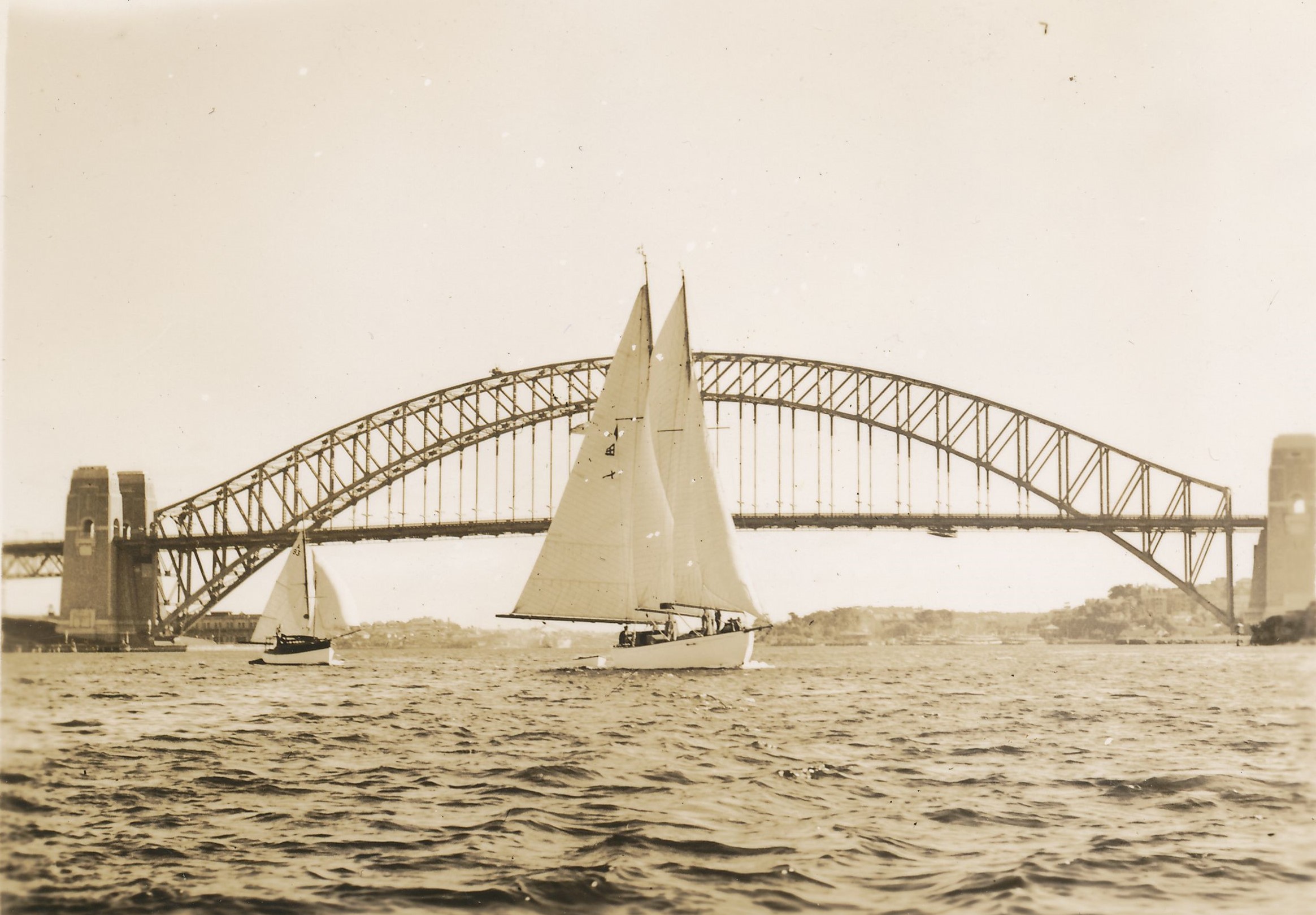
The Sirius arrives home
Coming home would have been doubly frustrating when unable to leave the yacht or have family aboard, as shown in the quarantine referred to above. No wonder his wife hugs her husband and her sons once she can:
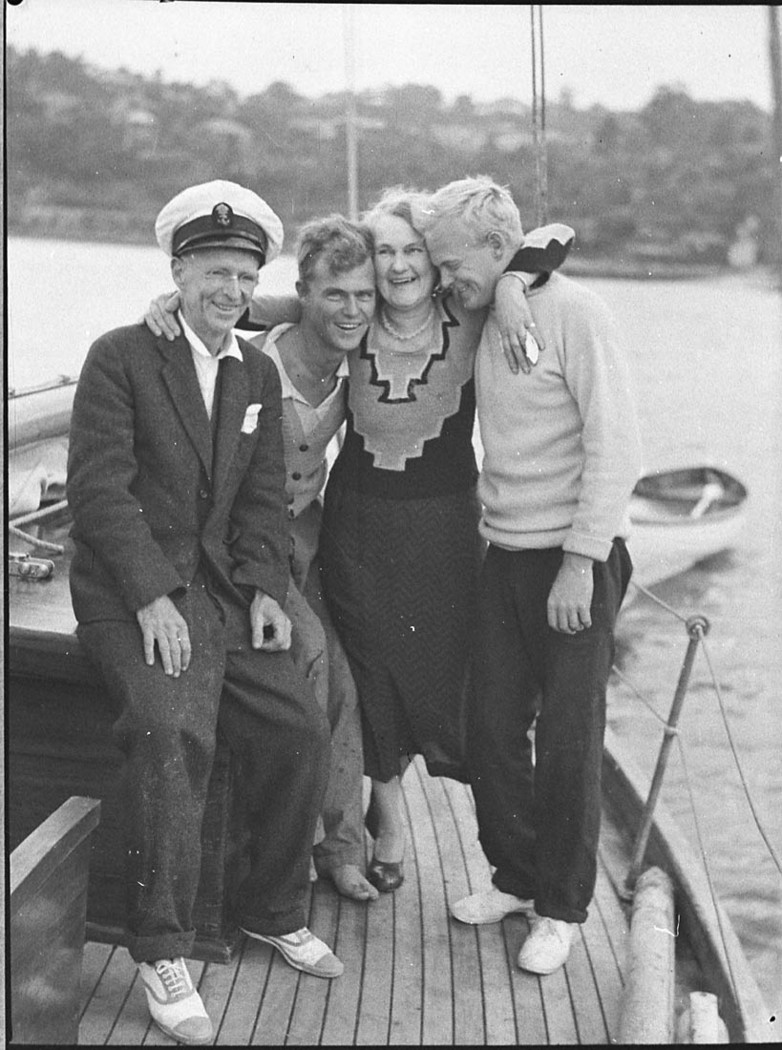
Return of Nossiter's yacht by Sirius from world cruise 1937. Image No.: hood_14965h, courtesy State Library of NSW
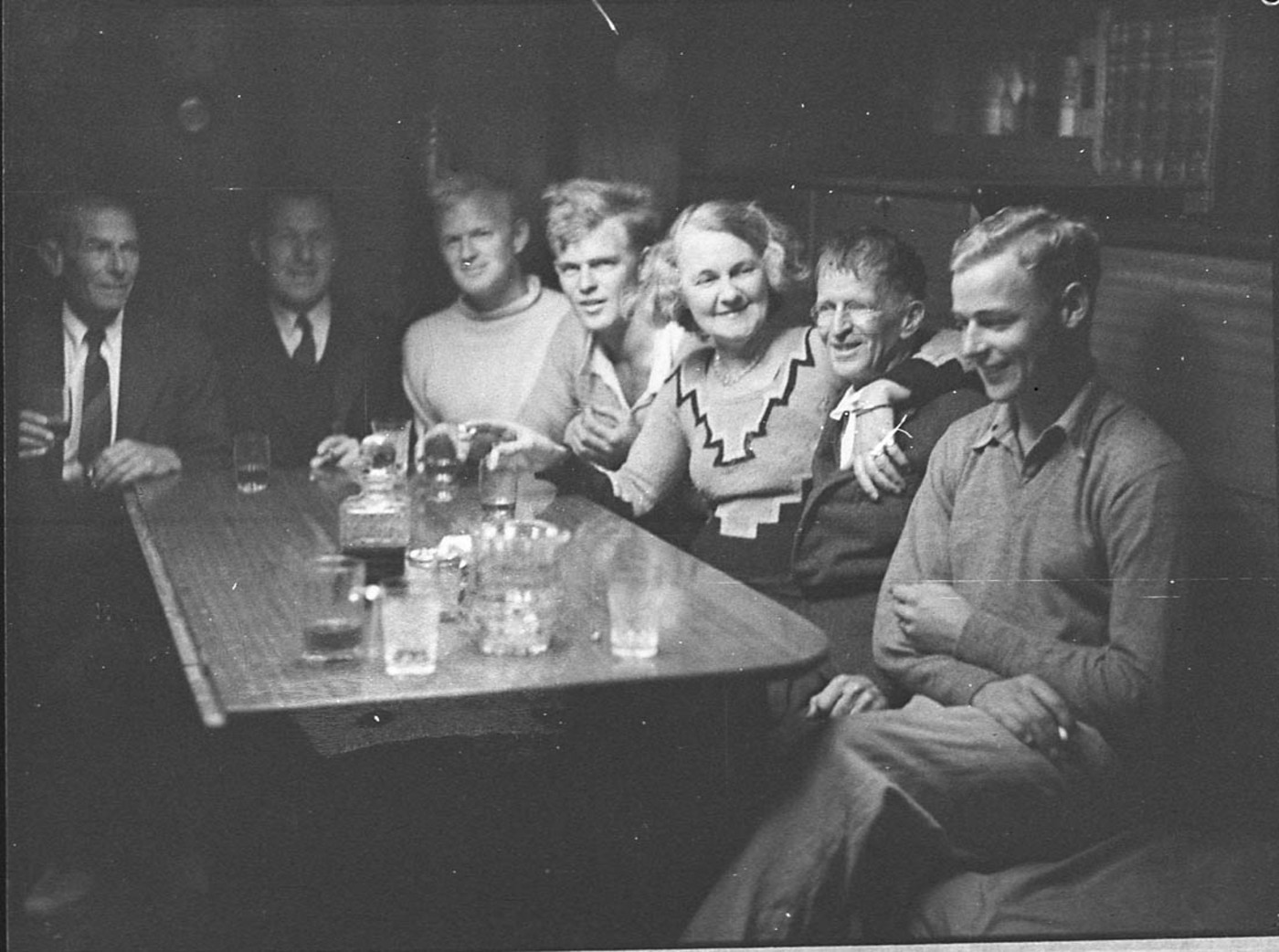
Return of Nossiter's yacht by Sirius from world cruise 1937. Image No.: hood_14964h, courtesy State Library of NSW
"MORE SEAS TO CONQUER."
Mr. Nossiter's Plans.
ROUND AUSTRALIA TRIP.
With 30,000 miles of travel behind him, Mr. Harold Nossiter, of Northwood, who brought his yacht Sirius to its moorings below his home yesterday, after a world cruise, is already thinking of new seas to conquer.
"I hope to circumnavigate Australia, but probably not in the old Sirius," he said. "I shall probably sell her and buy a smaller ship, one which can be handled by a couple of men."
Yesterday afternoon Mr. Nossiter had not had time even to shave or change his sea-going clothes. By 4 p.m. 100 friends and relations had called. 39 telegrams had arrived, and the 'phone had been answered 67 times. "I did not know I had so many relations," said Mr. Nossiter.
The first move made by Harold and Richard Nossiter, who sailed on the Sirius, was to take a taxi to the city and have a haircut. Their youngest brother described them as "looking like Rasputin."
DANGEROUS LIVING.
"The trip taught me," said Mr. Nossiter, "that to live dangerously Is always interest-ing. You can't travel round the world with-out striking danger, but only once were we thoroughly scared.
"We had marvellous luck the whole time, but as we approached Australia my one thought was to get home as quickly as possible. I am not a superstitious man, but a strange feeling came over me that fate had been too kind. When we were 800 miles from Sydney a gigantic waterspout formed and rushed toward us, and we knew there was grave danger of being wrecked.
"It was about 500 feet high, a great black tunnel Joining sea and clouds. We were direct in its path. I thought it might break if I fired a shot through it, and I had Just gone below to get a rifle when it collapsed. It was only 200 yards from the ship."
Mr. Nossiter and his sons saw many strange sights, and met many unusual people during the voyage. At Bora Bora, near Tahiti, they talked with.' Alain Gerbault, the French yachtsmen who sailed a craft single-handed round the world some years ago. Gerbault has become champion of the natives against the French regulation prohibiting the wearing of native costume. "MORE SEAS TO CONQUER." (1937, May 22). The Sydney Morning Herald (NSW : 1842 - 1954), p. 14. Retrieved from http://nla.gov.au/nla.news-article17370445
Once home Harold Nossiter Snr. gave a series of talks on his return while his books, duly published, were cited as a valuable resource for others venturing to seas along the courses they had taken. His efforts to share information in his own candid no-nonsense way was similar to that work done by Walter Marks on his return from England after the cancelled due to WWI Americas Cup event of that year - Mr. Marks had also been a RPAYC member, which has as its base, still, to share the passion for and promote the sport of sailing.
ADVENTUROUS YACHTING.
Mr. Harold Nossiter, a well-known Sydney yachtsman, performed a magnificent feat of navigation and courage when he sailed his 53ft schooner all the way from Sydney to London and has written a book on his experiences of such lengthy ocean cruising. The book is of excitement lo the specialised yachtsman and lay romantic alike, for the accomplishment was so considerable. For the large part of the trip the vessel, Sirius, was sailed by three men only-Mr. Nossiter and his two sons. The number of miles sailed reached the astounding total of 13,723, and of these only 380 were done under power. The route followed was, roughly, Sydney, Rabaul, Buton, Batavia, Singapore, Penang, Colombo, Aden, Port Said, Crete, Athens, Malta, Gibraltar, and Plymouth, but these intrusions of the land meant little to Mr. Nossiter. It was the sea always that provided him with his mile posts to achievement-the currents, the moods, and tempers of the sea.
Consequently the description of his voyage is made up largely of weather reports and sailing directions. Strangely enough this does not pall on the layman-probably because Mr. Nossiter does it all so simply. In addition, there is a most valuable appendix on ocean cruising containing all the details necessary for a trip half-way round the world in a small yacht. At the conclusion Mr. Nossiter says that he Is preparing for his return to Australia by which he will completely circumnavigate the globe. It is to be hoped that he will give us another book on this voyage, ("Northward Ho" by Harold Nossiter; H. F, and G. Witherby; Dymock's.) ADVENTUROUS YACHTING. (1937, April 3). The Sydney Morning Herald (NSW : 1842 - 1954), p. 12. Retrieved from http://nla.gov.au/nla.news-article17356816
THE VOYAGE OF THE SIRIUS
"Northward Ho," by Harold Nossiter. Published by H. F. and G. Witherby Ltd., London.
ON July 14, 1935, Harold Nossiter, a prominent Sydney yachtsman, with a crew of three, which included his two sons, left Australia in a 35-ton staysail schooner on a trip to England and back. The Sirius was specially built in Sydney for the 28,000 miles voyage and she is a modern yacht in every detail. England was reached in June 2, 1936, after a comparatively uneventful voyage and the Sirius returned to Sydney a week or so ago. While in England Mr. Nossiter set down an account of the forward voyage which now appears under the title "Northward Ho." It is a plain unvarnished story of the trip and has no particular literary merit, for Mr. Nossiter himself admits that he is no literary man, "least of all a stylist."
The book, perhaps, will be most appreciated by yachtsmen, for apart from Mr, Nossiter's thumbnail' descriptions of places on and off the beaten tracks of sea voyagers his narrative tells largely of winds and seas and sails. There is a long addendum to the book in which the author gives detailed notes on ocean cruising, and because of his experiences in this direction, experiences snared by but a few, Mr. Nossiter should find an appreciative audience among readers who are interested in the practical work of sailing ships, and of meeting the many situations which tides and winds and seas create whether in bay or ocean cruising.
Ports of Call
MR. NOSSITER has something Interesting to say of the Various ports of call; of Rabaul where he found the white population rather pale and an absence of the tanned complexion: of Komodo, the home of dragon lizards, but where none were found although a good search for them was made; of charming Ball with a people as yet unspoiled by tourists; of the quaint looking open vessels with painted hulls which were seen by the hundreds In the Java Sea; of Batavia with Its imposing buildings and hotels and where the Dutch authorities have done excellent work in keeping down diseases among the native population.
But for the fact that the engine (which was seldom used) responded quickly at a critical time the voyage might have ended on the voyage to Singapore at a spot called Middle Rocks. The yacht, caught in the current, was only a length off the rocks when the engine was started up. After Singapore the Sirius was tossed about in confused and broken seas whilst negotiating the difficult Malacca Strait, and It took eleven days to do the 400 miles, from Singapore to Penang.
A call was made at Pulo Langkawa and then the yacht sailed to Colombo through the Bay of Bengal. across the Arabian Sea to Aden, and on to Suez, whence the crow made excursions to Cairo and the Pyramids. Mr. Nossiter found that although the Pyramids and Sphinx were picturesque they were rather disappointing, as he expected to see something much larger and grander. They were not as interesting to him as the relics from Tutankhamen's tomb seen in the Cairo Museum.
An Italian pilot took the Sirius through portion of the Suez Canal. He was a pilot who talked politics. "This man," says Mr. Nossiter. "was of a very definite opinion that his country had got .nothing out of the war whilst other countries had obtained colonies, and that Italy had great need for expansion as she was over-populated." The pilot also Informed Mr. Nossiter that there were 2,500,000 Italians in Australia. "But when I pointed out that the population of Australia was only 6,500,000 all told, of which 97 per cent were of British stock," says Mr. Nossiter, "he did not appear to believe me, and declared that the schools taught otherwise. The Italian pilot also went on to say that the British colonies had had enough of the last war and would not help Great Britain were she embroiled in another, and furthermore that she would not succeed without the help of the colonies."
Worse for Small Craft
THE crew of the Sirius found the Mediterranean seas quite unlike those of the open ocean. They were short and steep and seemed to come from different directions making It worse for a small craft than did the long rollers of the ocean. The Sirius put Into Spinalonga Bay In Crete, an Imperial Airways base. Here old customs and traditions obtain. "Girls are strictly brought up and never allowed to mix with the opposite sex unless accompanied by their parents or brothers. Fathers have to supply the daughter, when she marries, with a dowry according to their wealth. A family of girls Is a great hardship as a poor man has to start saving for his daughter's dowry from the time of her birth, and many men receive their start in life with 'the dowry they get with their bride."
After calling at Candia, where the tourists found much to interest them In the ruins of the Palace of King Minos at Knossos, the Sirius sailed to Athens which, they found, was rather spoilt by the poor buildings and narrow dirty streets on the outskirts of the city. The Corinth Canal, through which the Sirius passed, was an imposing sight and much beautiful scenery was seen In the Gulf of Corinth. Argoatoll, the capital of the island of Cephalonia, Malta, and Gibraltar, were other ports of call before the Sirius passed Into the Atlantic Ocean and Into the Bay of Biscay, where the sea was like glass. On June 2 the Sirius reached Plymouth — Journey's end.
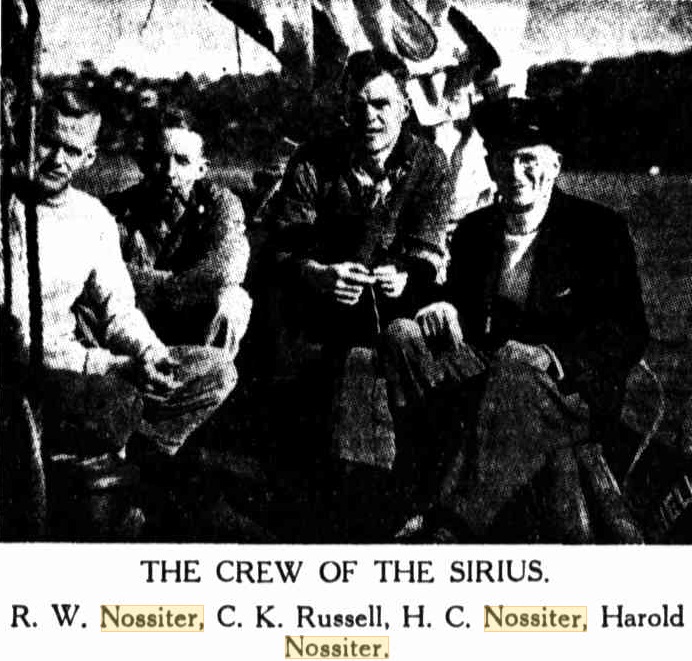
VARIOUS BOOKS (1937, June 12). The Telegraph (Brisbane, Qld. : 1872 - 1947), p. 14 (LATE WEEK END FINAL). Retrieved from http://nla.gov.au/nla.news-article191721565
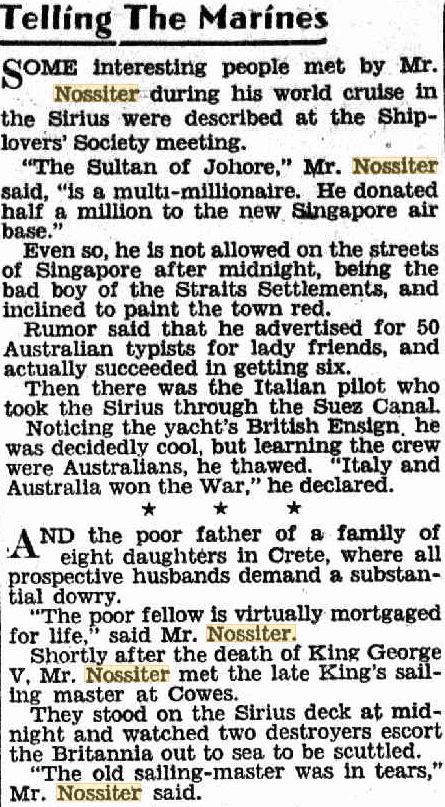
The Two Million (1937, August 20). The Daily Telegraph (Sydney, NSW : 1931 - 1954), p. 6. Retrieved from http://nla.gov.au/nla.news-article247226854
Mr. Harold Nossiter, who recently sailed round the world with his two sons in a Sydney-built yawl, the Sirius, will give a lecture tomorrow, at 8 p.m., to the Geographical Society of New South Wales, at the rooms of the Royal Empire Society, Bligh Street. No Official Advice (1937, September 14). The Daily Telegraph (Sydney, NSW : 1931 - 1954), p. 7. Retrieved from http://nla.gov.au/nla.news-article247232865
The Nossiter family also bothered to take photographs of this epic journey and this gift has also, perhaps unintentionally, added depth and knowledge to the Australian story as they generously shared these sights, from those times, too. A series of these featured in the Sydney Mail on their return. In 1989 Mr and Mrs Harold Nossiter Jnr. donated approximately 700 nitrate negatives of sailing trips undertaken by Harold Nossiter Snr and his two sons between the years 1922 and I941. The collection includes images of cruises along the New South Wales coast as well as the 1935-37 voyage around the world on Sirius. Most of the photographs were taken by Harold Nossiter Snr. and Harold Nossiter Jnr.
Tim Nossiter has also donated numerous items, including the charts and other materials during the past years and just last week in an April 2019 visit to Sydney.
These photographs not only featured in numerous articles published Australia wide they also gave those attending or giving welcome home events a great insight - a picture told a thousand words then too. The yacht clubs he was a member of provided welcomes - including the Royal Prince Alfred Yacht Club:
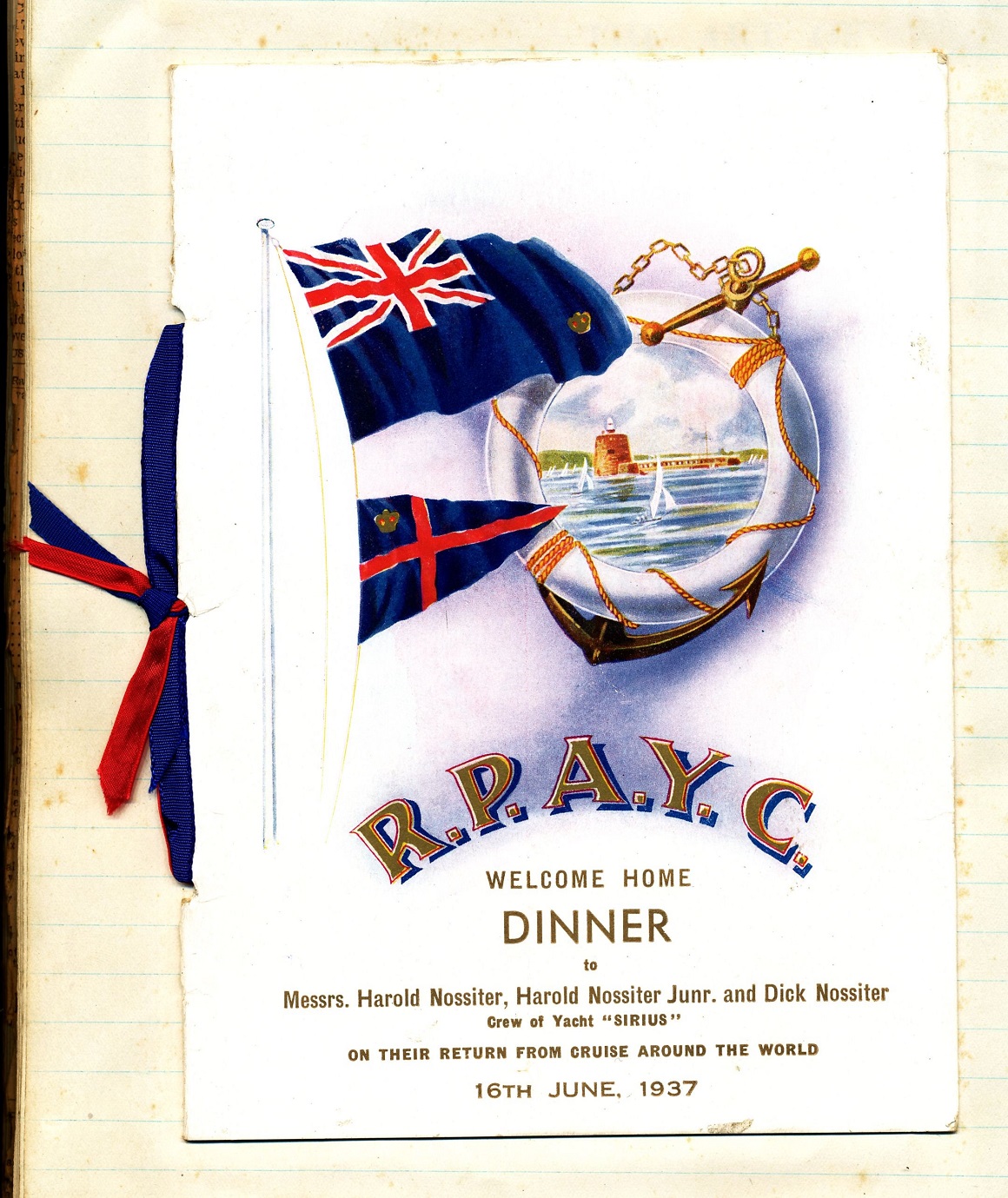
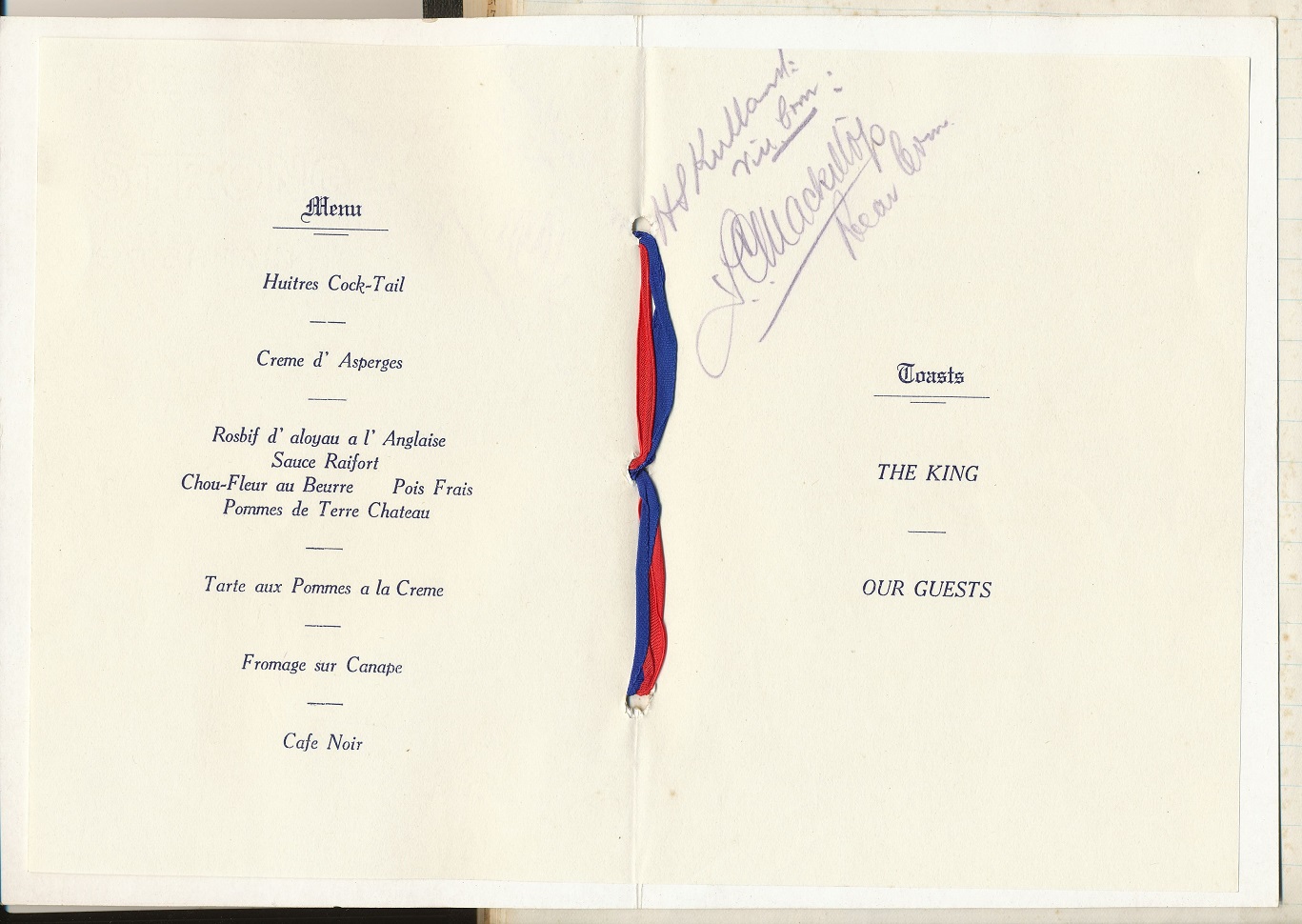
By July Richard had placed an advertisement offering
NAVIGATION for Yachtsmen Taught by R. H. Nossiter, Northwood. Telephone. J5H63. Advertising (1937, July 10). The Sydney Morning Herald (NSW : 1842 - 1954), p. 1. Retrieved from http://nla.gov.au/nla.news-article17376486
While his father was planning his next adventure, as stated above:

Advertising (1937, September 18). The Sydney Morning Herald (NSW : 1842 - 1954), p. 2. Retrieved from http://nla.gov.au/nla.news-article17419295
The Sirius did not sell - Australia was still in the grip of The Depression. Richard's father was busy speaking as well as sailing as skipper on other yachts in harbour races during the Season. The second book, Southward Ho, available late in 1937, was lauded and applauded throughout early 1938. The family were again at a Pittwater by year's end - for the launch of the first Jubilee race on Pittwater and the annual Pittwater Regatta:
MISS PEGGY COLBERT, daughter of Mr. and Mrs. P. E. Colbert, of Strathfield, will be the guest of Mr. and Mrs. Harold Nossiter on their yacht Sirius, which is at Pittwater until after the New Year. Spotlight on Society (1938, December 28). The Sun (Sydney, NSW : 1910 - 1954), p. 9 (LATE FINAL EXTRA). Retrieved from http://nla.gov.au/nla.news-article231131578
On the 16th of February 1939 Richard was appointed a Sub lieutenant of the Royal Australian Naval Volunteer Reserve (R.A.N.V.R.), a reserve force of the Royal Australian Navy.
Royal Australian Naval Volunteer Reserve.
Appointments.—Joseph William Barnes is appointed Sub lieutenant (on probation), dated 1st February, 1939. The following are appointed Sub-Lieutenants (on probation):—
Alexander Henry Brittain, Laurence William Harvey, John Vernon Lobb, Roy Lockwood, Graham Scholefield Maim, Richard Harwin Nossiter, John Darcy Shelley, John Stanley Lachlan Stevens, and Noel Somerville Townshend, dated 16th February, 1939.—(Ex. Min, No. SO.) G. A. STREET, Minister for Defence. NAVAL FORCES OF THE COMMONWEALTH. (1939, March 30). Commonwealth of Australia Gazette (National : 1901 - 1973), p. 510. Retrieved from http://nla.gov.au/nla.news-article232681306
By 1860 the New South Wales government began talking about forming some in house defenders instead of relying on the presence of a British fleet that could be called to other 'stations' in Australia and the surrounding area - New Zealand for instance. In May 1863 the Naval Brigade, of only 120 men to begin with, was established. The Naval Brigade headquarters was established at Fort Macquarie, where the Sydney Opera House today stands. By 1864 it consisted of five companies, four in Sydney and one in Newcastle, with an overall strength of 200 men. In 1880 the British gave New South Wales the Wolverene - with the first training taking place here, at Broken Bay and on Pittwater. Through various formations, and compulsory training being instated and then suspended, the brigade developed.
On September 3rd 1939 Prime Minister Robert Gordon Menzies announced the beginning of Australia's involvement in the Second World War on every national and commercial radio station in Australia. Richard Nossiter immediately signed up. At the outbreak of World War II (WWII), the RAN Reserve Forces comprised: RANR (S), 86 officers; RANR, 222 officers, 3869 ratings; RANVR, 223 officers.
On November 11th, 1939 Richard was appointed to Penguin for 26 days training, this being the reason why he is not present at the last Pittwater Regatta there would be until the cessation of hostilities.
In 1939, Penguin (Garden Island) was the Navy's main base in Sydney. At the outbreak of war, additional support bases were established in Newcastle, Brisbane and Darwin and each of these was also named Penguin. Penguin's motto is 'Proud to Serve'. In 2017 Narrabeen gentleman William (Bill) Fitzgerald OAM shared some insights into the Penguin's 75th anniversary of the commissioning of HMAS Penguin in 1942.
LARGE ATTENDANCE AT PITTWATER.
Patriotic Funds to Benefit.
A BEAUTIFUL silver cup is to be presented to the president of the 33rd annual Pitt-water Regatta, Mr, A. D. Walker, who has just retired from the position of commodore of the Royal Motor Yacht Club, which he has held for many years. The cup is engraved with the signatures of the donors-Messrs. Stuart Doyle. H. P. Christmas, and E. R. Williams, and members of their families.
The cup has been well earned, for yesterday, the Pittwater regatta, in aid of the Lord Mayor's Patriotic Fund, for which Mr. Walker and members of his committee have worked so hard, was a tremendous success. Thousands of people arrived in cars, and in their own boats. Many had already been up at Palm Beach, Newport, and neighbouring districts over the Christmas week-end.
An excellent opportunity for displaying summer clothes was offered. Slacks with bright coloured pullovers, dirndls, play suits, shorts and Hawaiian shirts were all favoured. Fish-net turbans had lost none of their popularity while brightly coloured "mammy" scarves formed many head-dress, and were worn with sun glasses.
On board the president's boat, the Lolita, Mr. and Mrs. Walker, the latter wearing a dark blue and white figured frock, entertained a number of guests including Mr. and Mrs. A. D. Walker, jun., the latter wearing a linen play suit appropriately decorated with anchors. Mr. and Mrs. Walker plan to stay at Pittwater for another week.
DAUGHTERS ASSIST
The Lord Mayor elect, Alderman Stanley Crick, and Mrs. Crick, who looked cool in in ice blue linen frock, entertained on board their boat, the Silver Arrow. They were assisted by their daughters, Misses Shirley and Patricia Crick, both in sun tops and shorts. The guests included Mr. and Mrs. A. E. Cruttenden, Mr. and Mrs. Guy Crick, Miss Olga Martin, and Mr Herbert Crisp. They were joined later by Mr. and Mrs. Alan Henderson, who have taken a cottage at Newport.
Keen spectators were Mr. and Mrs. Harold Nossiter, the latter wearing a light green linen frock, and their guests, who had all spent Christmas on board their famous boat, the Sirius, in which Mr Nossiter and his sons did a two years round-the-world cruise some years ago. On board her were Misses Thea Mowle, Billy Williams, Messrs. Jack Nossiter, Ron Potts and Harold Nossiter. … LARGE ATTENDANCE AT PITTWATER. (1939, December 27). The Sydney Morning Herald (NSW : 1842 - 1954), p. 5. Retrieved from http://nla.gov.au/nla.news-article17633066
The Royal Navy drew most of its loan personnel from Australia from the ranks of the RANVR during WWII. In June 1944, out of the 500 Australians serving with the Royal Navy, more than 400 of them were members of the RANVR. Although it became clear early in the War that although there was no shortage of applicants, there was limited demand for naval volunteers in Australia, not least due to the lack of instructors and training facilities. The RAN gazetted a separate Yachtsmen Scheme in June 1940 and under this scheme some 500 volunteers were selected and sent to the United Kingdom for training as members of the RANVR. Initially the volunteers were selected from men with yachting experience.
In January 1940 Richard Harwin Nossiter embarked on the Cerebus for England.
His brother Harold would also serve on the water, becoming part of the Motor Boat Crew and being sent into New Guinea, while John (Jack) would serve in the Army (A.I.F.) and Bennet (Ben) would take the skies - becoming part of an Australian Spitfire Squadron that would move from Australia to Canada to train and then be sent into England. All became Officers.
Even the Sirius served in WWII - she was part of the Water Transport training units. The 3rd Water Transport Group, Royal Australian Engineers (RAE) was formed in 1943. As there were very few personnel recruited or trained in small craft or barge handling a number of separate Water Transport Training Schools were established, including one at Clifton Gardens, beside Taronga Park Zoo in Sydney.
MUST REGISTER SMALL VESSELS
CANBERRA, Friday. — Owners of small vessels must register them with the Navigation Branch in each State under National Security orders gazetted today. The notice gazetted states that all owners, on February 15, of vessels not less than 15 feet nor more than 50 feet in length, not ordinarily propelled by oars (including punts and barges) must fill in a comprehensive form. The form must be completed by owner and sent to the Navigation Director in the State before March 31. An Information Department spokesman said in Sydney last night: "Owners of boats should understand that the furnishing of the return does not necessarily mean that the vessel will be requisitioned. "But it is important that the Navy should take a census of the boats, and have the detailed information asked for." MUST REGISTER SMALL VESSELS (1943, February 27). The Daily Telegraph (Sydney, NSW : 1931 - 1954), p. 10. Retrieved from http://nla.gov.au/nla.news-article247858827
SIRIUS FOR YACHT RACE
Sirius, the 53-foot schooner in which Harold Nossiter and two sons sailed around the world in 1935, will start in this year's Sydney-Hobart yacht race.
Twenty-two ocean-going vessels, representing New South Wales, Victoria, Tasmania, and New Zealand, have entered for the race. Ilex the New Zealand representative, is now on her way across the Tasman for the start— off Clark Island (Sydney Harbor) on December 26.
Sirius was used during the war as an Army Water Transport training vessel. She is now owned by Jim Booth, well-known racing yachtsman, who has completely refitted her for off-shore racing. Sirius will have a "tune-up" race on Saturday in the Cruising Yacht Club's 20-mile handicap from Sydney to Broken Bay. Post entries for the Sydney-Hobart race will be received until December 10. SIRIUS FOR YACHT RACE (1946, December 4). The Daily Telegraph (Sydney, NSW : 1931 - 1954), p. 24. Retrieved from http://nla.gov.au/nla.news-article248398244
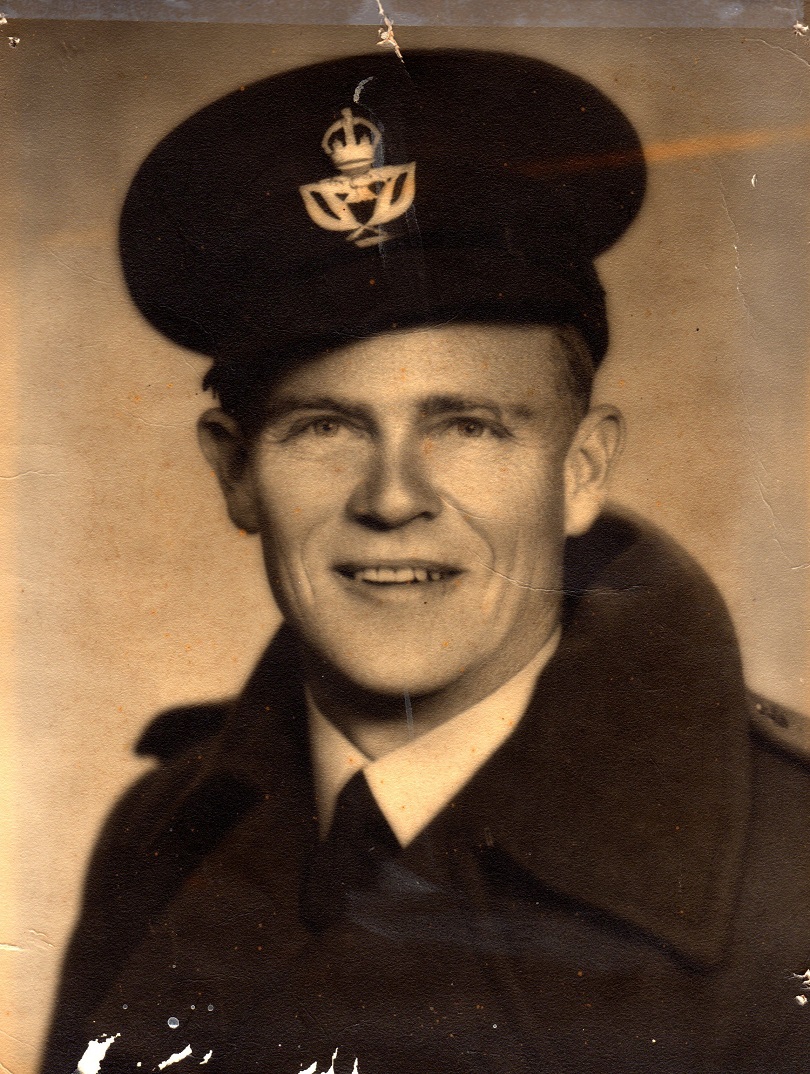
Harold Charles Nossiter - WWII
Yachtsman Marries
A SUGAR model of the yacht Sirius, in which the bridegroom has sailed round the world with his father, Mr. H. Nossiter, decorated the wedding cake at the reception after the marriage yesterday of Miss Elizabeth Williams and Mr. Harold Nossiter. The bride is also a yachting enthusiast, and they will spend their honeymoon in a yacht that has been lent to them. The ceremony took place at All Saints', Hunter's Hill. Yachtsman Marries (1940, February 11). The Daily Telegraph (Sydney, NSW : 1931 - 1954), p. 33. Retrieved from http://nla.gov.au/nla.news-article248236547
Richard Harwin Nossiter WWII Service
Written by and photographs Richard H Nossiter and Steven Nossiter (son)
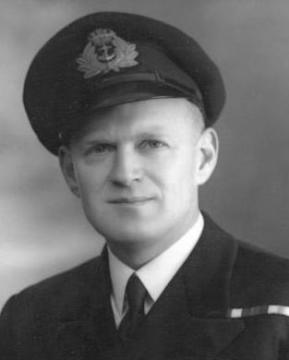 Richard Harwin Nossiter DSC OAM was born on 22nd June, 1910 at Champion Road, Tennyson, Municipality of Ryde, New South Wales.
Richard Harwin Nossiter DSC OAM was born on 22nd June, 1910 at Champion Road, Tennyson, Municipality of Ryde, New South Wales.
The following is Richard Nossiter’s service record taken from “Contact” HMAS Rushcutter and Australia’s Submarine Hunters 1939-1946. Edited by G R Worledge Sydney. First published 1994 by Star Printery Pty Ltd.
NOSSITER R H (Dick) b 1910: Joined RANVR as Sub Lieutenant: HMAS Rushcutter (A/SCO Course) 1939, one of “Original 66”; served HMT Loch Monteith (A/S trawler) as First Lieut (North Sea) 1940; HMS Mallow (corvette) as First Lieut (North Atlantic) 1940-41; HMS Paynter (trawler) as CO (North Atlantic, Russian convoys, North Sea) 1941-43; HMS Potentilla (corvette)as CO (UK waters) 1944; HMS Godetia (corvette) as CO (North Atlantic. UK waters, Normandy) 1944-45; staff appointment (Germany) 1946; demobilised 1946, Lieutenant Commander; DSC.
On 19th March I duly took up my first appointment as First Lieutenant of HMT Loch Monteith in Liverpool and arriving on board found no officers had yet arrived. The Coxswain invited me to the PO’s mess and the time being close to 11.00 hrs thought ‘Up Spirits’ was called for so handed me a large glass of neat Pussers rum. I did wonder how this was accounted for and discovered later that it was sometimes best to turn a blind eye to certain customs in trawlers.
We carried out patrols in the North Sea sometimes boarding small vessels to check their cargo. Whilst leaving harbour one day I had my first attack of renal colic. The ship returned to hand me over to an ambulance to be hospitalised for a week.
Following this episode I was appointed Number One to Mallow, a Flower Class corvette having just been completed in Belfast, and stood by whilst she was fitted out. She was duly commissioned and we commenced our duties escorting convoys in the Atlantic based at Londonderry and Liverpool. This was about the middle of 1940 to 1941 when the U-boat warfare was hotting up.
Although our convoys were often attacked, a number of ships torpedoed and many depth charges dropped we never had a confirmed submarine contact. However we did see plenty of foul weather.
Whilst based at Liverpool the Luftwaffe commenced dropping acoustic mines in the Mersey just before the Ark Royal was about to sail. There was a big flap on and I believe these were the first acoustic mines to be layed. We received a signal to steam up and down the Mersey at 12 knots. Nobody told us why but we could guess!! Corvettes were expendable and if we cleared a path for the aircraft carrier well, fine. Fortunately for us one of Liverpool’s pea soup fogs drifted in and the operation was cancelled.
My next appointment was CO of a Cricket class trawler HMS Paynter of about 850/900 tons. We were based at Belfast and spent most of our time escorting convoys along the east coast of England and from Loch Ewe to Iceland and back. At dusk Christmas Eve 1941 we were escorting a convoy up the east coast of England on the starboard beam of the convoy. The SO escort, in a destroyer, was about to depart to be replaced by another. As he was leaving he sent the following signal: “I am leaving you now. A submarine has been reported 50 miles ahead. E boats are active to the south, a mine has been sighted on the starboard bow of the convoy. Have a Happy Christmas.”
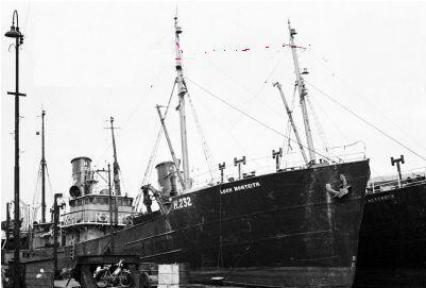
Photo - HMT Loch Monteith (A/S trawler)
I said to Number One who had the watch, “It looks like being a busy night. I’m going below to have a short rest before the balloon goes up. Keep a good lookout for the mine and close the convoy for a while.” I was dozing off on the settee when a call came from the bridge. “Captain, you know that mine that was reported!” I said, “Yes.” “Well we just hit it!” It took a few seconds for the message to sink in. I sat up with a jerk and said, “What did you say?” He answered, “The mine just went clanking along the side but it didn’t go off!” So ended my little rest. The remainder of the night was without incident.
Convoy To Murmansk
One memorable convoy was from Iceland to Murmansk. We were part of an A/S escort for PQ13 consisting of two destroyers, a minesweeper and two trawlers with one cruiser Trinidad accompanying as close cover and another west of Bear Island in support. Nineteen merchant ships sailed on 20th March 1942 and ran into ice in the vicinity of Bear Island. Paynter nearly got stuck in thick pancake ice and as we were finding it extremely difficult to push through we steamed in the wake of a large merchant ship and let her break it for us. However large slabs of ice slid under our bows and wiped off the ASDIC dome.
Photo - HMS Paynter (trawler)
East of Bear Island the convoy was located by aircraft and repeatedly attacked by dive bombers. Three ships were sunk. The following day Trinidad and the destroyer Eclipse came in contact with three enemy destroyers and in a brief engagement in very low visibility one enemy destroyer was sunk and others damaged. Trinidad emerged from the fog with a list and smoke pouring from a hole in her side. There is a theory that Trinidad torpedoed herself. According to the story she fired torpedoes and a shell burst in the water and turned one of them back on to herself. A book has been published about this titled ‘The Ship That torpedoed Herself’ by Frank Pearce a survivor. Trinidad made it to Murmansk but was sunk by aircraft on the way back.
As we were a coal burning ship we had to get coal. Eventually Russian women came down to do the coaling. The coal came in bags and there were openings on the deck where the coal had to be poured into the bunkers. We finally received enough coal for the trip. On the way up we were bombed by flights of planes. There would be about 20 or so of them and everyone would let fly firing on them. One pilot bailed out and his plane went into the water. Another one went away with smoke coming out of it. We got some of them but they couldn’t stay long as they didn’t have enough fuel. Then another lot would come.
Photo - HMS Mallow (corvette)
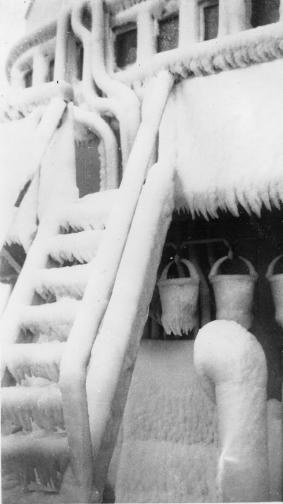
In Murmansk we had to fend for ourselves as we were quite isolated and on our own. Planes came from Finland and bombed us in port every night. There were no shops, couldn’t buy anything as it was just a port. We didn’t run short of food as we got a barrel of salt pork which was terrible. I went round to one of the merchant ships and traded them some bottles of gin for some frozen chooks. We had one or two decent meals in the wardroom then.
The return convoy QP10 was subjected to air and U-boat attack for three days while on passage between Kola Inlet and Bear Island and four ships were sunk. When we left Murmansk with the convoy I saw this ship that had been bombed so I broke off to see if I could pick up some survivors. There were a lot of them, some in the water, others on rafts and others in boats and some of those men had been in the water for perhaps 10 minutes to 1/4 hour as when they lowered the lifeboats they capsized.
In those conditions they reckoned that 3 minutes was all that the human body could stand. We got about 6 of the men. In the meantime there were other boats and rafts drifting away. I eventually got about 50 or so of men. Whilst picking up survivors a plane flew over and machine gunned us but nobody was hit. Somebody reported a; I never saw it and there was little we could do anyway as we had no ASDIC. Also survivors were scattered over the area and I didn’t feel like dashing amongst them dropping depth charges on an unconfirmed periscope sighting. We had a spirit compass and the spirit froze and cracked the glass causing a large bubble. I filled it with gin and it was as good as ever.
In the middle of it the Captain came up to the bridge and said there were seven men still on board. He got into trouble for that as he wasn’t the last to leave the ship. A captain never leaves the ship he often goes down with it. He had left the men on board. These men were on the poop of the ship. I couldn’t work out how to get them off. They wouldn’t jump into the water as it was too cold for that. So I nosed around just under the poop and told them to jump. There were about seven of them I think. Some did and some didn’t and then with the sea the stern came down on my guard rail and smashed it so I went full astern. As soon as I did that the rest of them jumped so I got them all.
Continuing back after picking up these survivors I realised that the convoy had moved on. I didn’t want to be caught here alone so I decided to steer so that the convoy would be between me and the land so I went a short distance out to sea. That way any planes coming would find the convoy first and not me.
The next morning about 11.00 o’clock there was a snow storm and you could hardly see anything. We had a lookout on the bow and he called out, “Ship ahead!” It was one of the convoy. We had found the convoy which was very lucky. We then took position on the wing of the convoy.
After we returned from Murmansk and celebrated in the wardroom. I said that I had made up my mind I was going to die and then I wasn’t afraid. My one thought was that I hadn’t left anything behind. Nothing. It was very difficult as I thought there would be no one to survive me. I had left Nancy at that stage and she was pregnant but she lost the baby when she heard that I was going to Russia.
I only had to do that trip to Murmansk once only.
Photo (far left) - Richard on HMS Paynter in 1943
MR. and Mrs. Harold Nossiter received a cable this week from their second son, Lieut. R. H. Nossiter, R.A.N.V.R., announcing his engagement to Miss Nancy Swan, daughter of Dr. George Swan, of Liverpool, England. Lieut. Nossiter is serving with the British Navy. A few years ago, Lieut. Nossiter and his brother sailed on a two years' cruise round the world with their father, in his yacht, Sirius. Now Mr. and Mrs. Nossiter are living aboard the Sirius, which is at anchor at Newport, after having been at Palm Beach.Another son, Mr. Jack Nossiter, will be married in August to Miss Thea Mowle. SUE SEES SYDNEY (1941, July 4). The Sun (Sydney, NSW : 1910 - 1954), p. 7 (LATE FINAL EXTRA). Retrieved from http://nla.gov.au/nla.news-article231631793
Photo (left) - Richard's wedding
A Copy of the original document awarding Richard the D.S.C. for bravery in taking convoys to and from Murmansk in Russia during WWII is available for download here.
The above also appears on the website Russian Arctic Convoy Museum
He received the DSC for bravery after the Murmansk convoy - which was widely reported back home:
Women's News
George Cross For Officer
From ELAINE BERKELEY
LONDON; Sunday, - There were resounding cheers, in one of London's gayest night clubs, the New Yorker, in Park Lane, when it was announced on the 9 o'clock B.B.C. news that the George Cross had been awarded to Lieutenant Stuart Mould, R.A.N.V.R., of Sydney. He already holds the George Medal. Lieut. Mould, who is known as "Mouldy," was in the club, and it was just as big a surprise to him as to his friends. Soon after the news had been announced, enthusiastic well-wishers tracked him to the club by telephone completely immobilising that instrument for many hours. Next time I saw "Mouldy" his pockets were stuffed with telegrams ; and stuffed in with them was the royal blue ribbon of the George Cross.' ' He has been so busy that up till now he had not had time to have toe ribbon sewn on his tunic. The New Yorker is so well patronised by Australians that it has been nicknamed "H.M.A.S. Australia." Murmansk Convoy
Back from a Murmansk convoy trip, I met Lieutenant John Nichol, R.A.N.V.R., of Perth. He said nonchalantly: "It's just routine, you know, lots of fun, but we expect that." Other members of the RA.N.VR. in small craft back from the icy north were Lieutenant Richard Harwin Nossiter D.S.C., of Northwood, and Sub-Lieutenant Roger Sturgess. He comes from Tasmania. At the popular Boomerang Club this week on leave were Pilot-Officers John Frazer (Lindfield), John Maxwell (Rose Bay), L. J. Connors (Newcastle). Flying-Officer N. N. McKeough (Kram-bach), well-known naval officer, Sub-Lieutenant. W. A. Wood (Neutral Bay), Radio-Officer Bill McLeod (Vaucluse), Sergeant-Pilots Ross Dodson (Ryde) and Ray Bruce (Lithgow). Women's News (1942, November 9). The Daily Telegraph (Sydney, NSW : 1931 - 1954), p. 8. Retrieved from http://nla.gov.au/nla.news-article247907295
Tragically the Nossiter lost one son in World War II - Richard's brother Ben. Ben was a wool-classer prior to his enlistment in July 1940:
AUSTRALIAN AIRMEN.
A New Spitfire Squadron.
LONDON, July 30.-
Inheriting the traditions of the Australian fighter unit with a glorious record in the Far East, another Australian Air Force Spitfire Squadron has been formed at a famous Scottish operational base. Squadron-Leader Squadron-Leader F. O. Morello, of the RAF, is the commanding-officer. Flight-Lt J. R. Cock, of Renmark (SA), who won the DFC in October, 1940. for his work with Hurricanes against great odds, both in France and in the Battle of Britain, commands a flight. Flight-Lt Cock has shot down 7 planes and baled out 3 times. The foundation members of the new squadron are Sgts Ronald Clyde Ford and Francis Roch McDermott (Lismore, NSW), Pilot-Officer Frederick Thomas Thornley '(NSW), Pilot-Officer Russel Herbert Ewins (Vic). and Sgt Gerald Whiteford (Canberra).
The flying personnel, apart from a few experienced pilots from other services, is all-Australian and includes Pilot-Officers Thomas Alexander Swift (Camberwell); Richard Joseph Darcey (North Hobart); Daniel Joseph Reid (Elsternwick); Charles Guy Riley (SA) and Sgt. Lionel James Hansell (NSW); James Raymond Furlong (Port Melbourne); George Jackson Stanfield (Richmond (Vic); Bennet Thomas Nossiter (Northwood); Wesley John White (Kew, Vic), and Matthew Henry Decosier (New Farm, Brisbane). AUSTRALIAN AIRMEN. (1942, July 31). The West Australian (Perth, WA : 1879 - 1954), p. 5. Retrieved from http://nla.gov.au/nla.news-article47341834
Group portrait of pilots of No. 453 (Spitfire) Squadron RAAF, based at an RAF Station at Drem. Left to right: Squadron Leader Morello, RAF Commanding Officer; 403046 Sergeant (Sgt, later Flight Lieutenant [Flt Lt]) Ronald Clyde Ford; 416291 Sgt David Hayward Steele; 403763 Sgt (later Flying Officer [FO]) Harold Mason Parker (lost on operations over the English Channel on 8 October 1943); 405111 Flight Lieutenant (Flt Lt, later Wing Commander) John Richard Ratten (died of illness in the United Kingdom on 27 February 1945); 401666 Pilot Officer (PO, later Flt Lt) Daniel Joseph Reid, Distinguished Flying Cross; 403278 Sgt, later PO Bennett Thomas Nossiter (lost on operations off the United Kingdom on 11 October 1942); FO Soliecki; 408172 PO, later Flt Lt Richard Joseph Darcey (accidentally killed over Manus Island on 6 October 1944). Circa June 1942, courtesy Australian War Museum.
FAMILY reunion in London when Lieut. Richard Nossiter, R.A.N.V.R., meets his brother, Sgt.-Pilot Ben Nossiter, on his arrival from Canada. Is introduced to Dick's English wife, Nancy, who is in W.R.E.N.S., and all three celebrate when Dick is awarded D.S.C. for bravery in convoy work to Murmansk. Ben is now in Australian Spitfire Squadron in Scotland. They are sons of Mr. and Mrs. Harold Nossiter, formerly of Northwood, but who are now living in their yacht Sirius, anchored in Alexandra Street Bay. Hunter's Hill. Their other two sons, Harold and Jack, are in R.A.A.F. and Army. Heard around TOWN (1942, September 19). The Australian Women's Weekly (1933 - 1982), p. 20. Retrieved from http://nla.gov.au/nla.news-article46233213
NOSSITER..—October 11 1942. previously reported missing air operations over the English Channel, now presumed dead Pilot-Officer Bennet Thomas (Ben), R.A.A.F. beloved youngest son of Mr, and Mrs. Harold Nossiter, late of Northwood, aged 23 years.Family Notices (1943, May 26). The Sydney Morning Herald (NSW : 1842 - 1954), p. 12. Retrieved from http://nla.gov.au/nla.news-article17850068
Ben is remembered on the Commonwealth Air Forces memorial at Runnymede. His body was never recovered from the sea.
On his return to Australia in 1946 Richard and his wife lived initially at 35 Tasman Street, Dee Why during April and then moved to Nossiter home at Northwood by October. His older brother Harold Charles would also return to live close to their childhood playground of Pittwater too - he retired to live with wife Jean at Narrabeen and passed away at the RSL Village on July 26th, 2005, aged 97.
Richard (Dick) was finally 'retired' from his naval reserve service in 1958:
Royal Australian Naval Volunteer Reserve.
Transfers to the Retired List.—The following are transferred to the Retired List to date 31st March, 1958 —Commander John David Bates Lieutenant Commanders Malcolm Birrell Gale, George Ewart Vaughan Glyndwr Owen, Richard Gordon Burnell, Richard Harwin Nossiter, DSC, … NAVAL FORCES OF THE COMMONWEALTH. APPOINTMENTS, ETC. (1958, June 12). Commonwealth of Australia Gazette (National : 1901 - 1973), p. 1922. Retrieved from http://nla.gov.au/nla.news-article240892445
Richard and Nancy bought the family home at Northwood from Harold Snr and Winifred and settled down. They had three sons, Steven, Hugh and Timothy, all sailors and yachtsmen. Tim lives in Tasmania where he was the Captain of a converted trawler “Penghana” at Australia's first Marine Education facility until retirement. Steven lives in Belmont North, N.S.W., which was just around the corner from his father. He sails his yacht on Lake Macquarie and has a son called Ben. Hugh also lives there and is famous locally, as a magician known as "Super Hubert", who Pittwater attendees of Palm Beach Mermaid fundraisers for Variety the Children's Charity may have laughed out loud with at Palm Beach dinners. Others would have seen him on those road trips the fundraisers embark on each year.
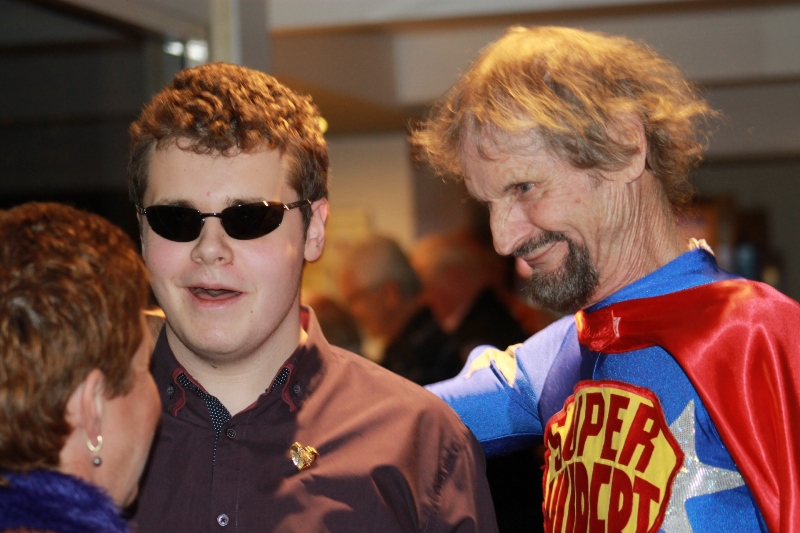
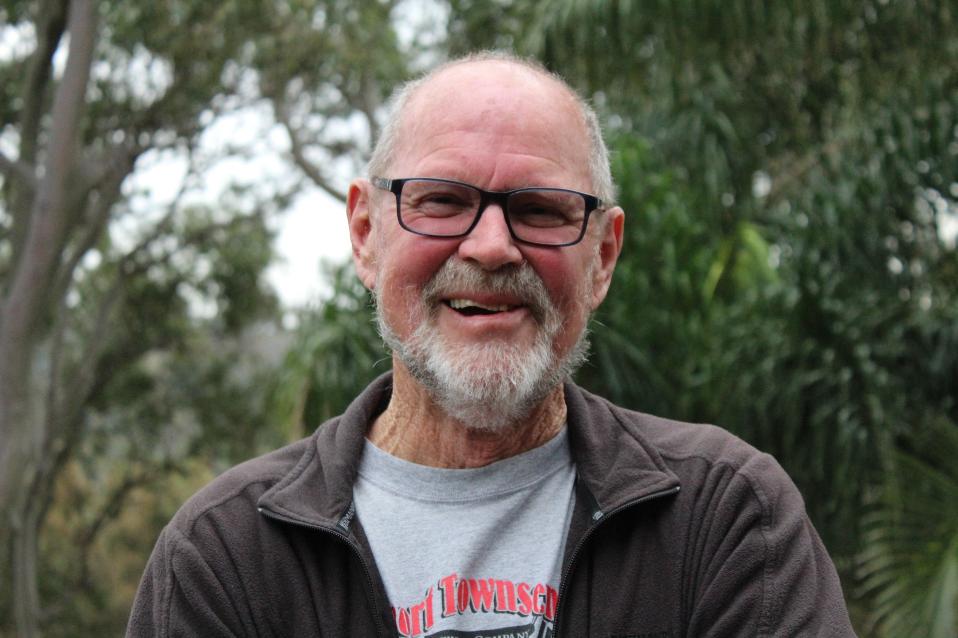
Richard Nossiter worked as a sales rep for Mungo Scott Flour Mills, securing large contracts from huge users of flour, such as Arnotts and Peek Freans. He was later promoted to sales manager.
He competed in five Sydney-Hobart races in friends' yachts and his three sons, Steven, Hugh and Tim competed with him in the first of these. He later became an alderman on Lane Cove Council and served nine years, one as Deputy Mayor and three as Mayor.
We asked Tim about his dad last year:
Did your dad tell you much about his Service during WWII?
Some, he did an immense amount for others. I recall one trip up into the Arctic circle he spoke of, which was when he got his DSC. They were basically suicide missions those trips. Luckily he survived and only did the one trip there and back. Those were horrific missions, absolutely horrific.
Did he come out scarred do you think?
Not at all. He enjoyed his time in the Navy. His fellow officers became lifelong friends of his.
He said he was pretty frightened in the beginning, especially when he was going to do this Murmansk run. My mum miscarried because she was so nervous about it, that’s what she put it down to. He said he suddenly thought ‘I’m going to die’ and then, as he said, ‘just as suddenly all my fear left me’.
He was the most beautiful man, just lovely – everyone adored him. He was humble, always ready to have a laugh, a wonderful guy.
How long did he sail for?
They sold Scotia eventually as we’d all left home and weren’t sailing with him anymore. He then sailed with a childhood mate of his, Jim Griffin. He did a couple of Hobart’s with Jim and would have been in his early 60s by then.
He sailed with me on the Yanda, joined me in Mooloolaba and sailed with us at to Mackay, was with us for two weeks. He would have been about 68 then. But then, I’ve just done this trip up from Tasmania and I’ll be 71 this year.
Dad was always quite fit though. Apart from sailing with my brothers up in Lake Macquarie, as they are both living in Newcastle now, and that’s where mum and dad ended up living too, the sail he did with me on the Yanda would have been the last longer at sea sail.
He also did one trip on Eye of the Wind back to Sydney with us from Hobart one year too – that was in 1984, so dad would have been 73 then. That would have been the last long one he did – and a wonderful experience for me.
After his retirement in 1975, Dick and Nancy moved to Newcastle, where two of their sons were living.
In June 2010, when Richard was the last surviving member of the crew and one week before his 100th birthday, he was awarded the Medal of the Order of Australia for the part he played on the voyage.
June 13, 2010: OAM Richard Harwin NOSSITER DSC, Cardiff Heights, NSW
For service to sailing through the circumnavigation of the globe in the vessel Sirius, 1935-1937.
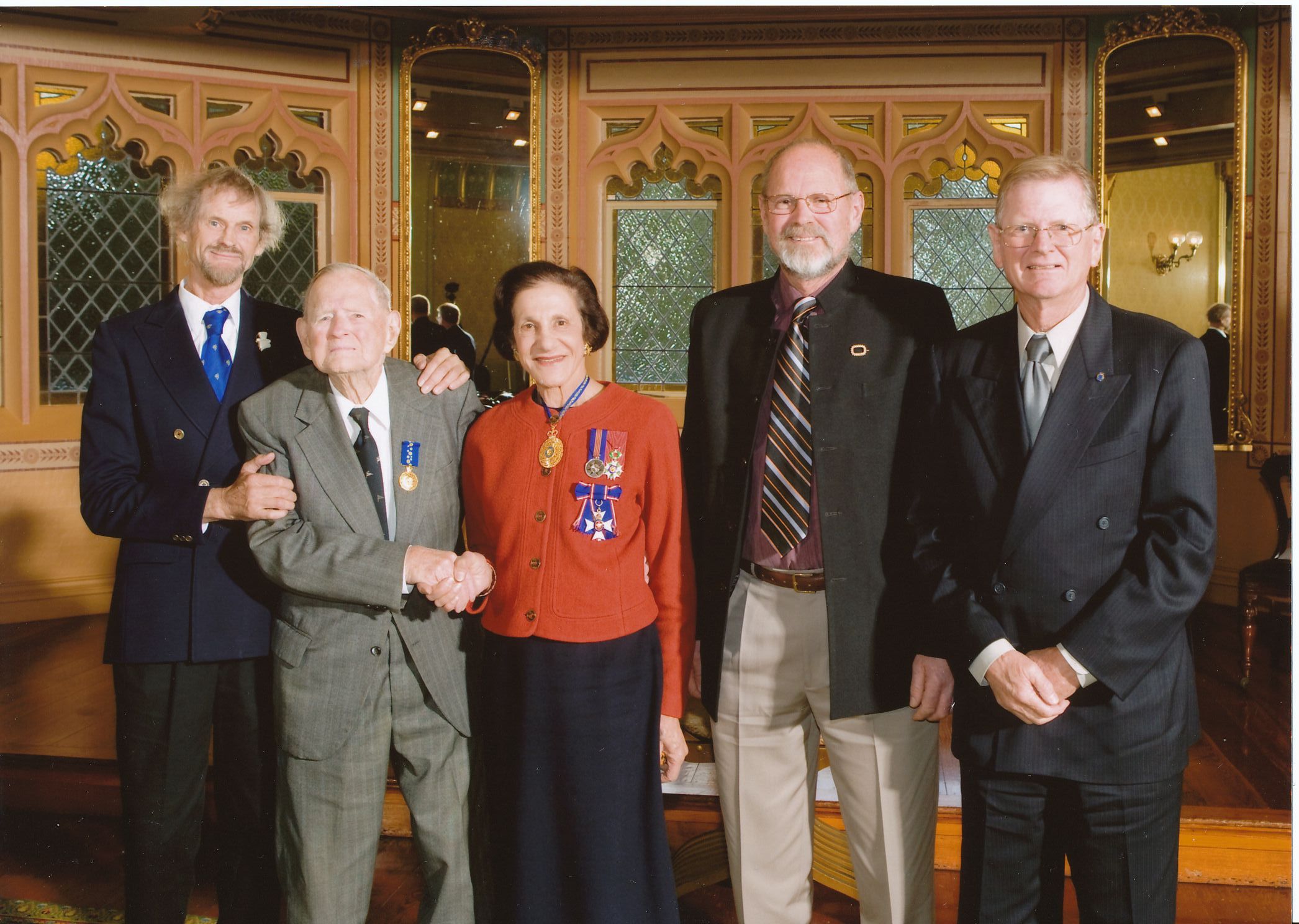
Dick Nossiter accepting his OAM from then NSW Governor, Dame Marie Roslyn Bashir AD, CVO in 2010, with his three sons (L to R) Hugh, Tim and Steven.
Nancy died in 2008 - they had been married for 57 years.
Dick's brother John who sailed the Sirius with his younger brother, Ben in those halcyon days before the war on Pittwater, moved to Perth, WA where he lived to the age of 87.
Richard Harwin Nossiter DSC OAM passed away on December 28th, 2013.
He is survived by sons Steven, Hugh and Tim, nine grandchildren and four great-grandchildren.
Dick Nossiter with a bottle of RPAYC house red - Tim Nossiter photo